ASUSTeK Computer AAM6KTPB2 Wireless ADSL Router User Manual AM200g
ASUSTeK Computer Inc Wireless ADSL Router AM200g
Contents
- 1. users manual 1
- 2. users manual 2
users manual 1

TriplePlay
User Manual
Version 1.0
Version Date: August 1, 2005
Document #: BD-TU0001-10

TriplePlay
User Manual 1
Version 1.0
Document #: BD-TU0001-10
Table of Contents
GENERAL INFORMATION ...............................................................3
Package Contents ..................................................................3
Safety Instructions—Please read. ...........................................3
Front Panel View ....................................................................4
Indication................................................................................4
Back Panel View ....................................................................6
INSTALLING THE ROUTER..............................................................7
Connect the ADSL Line and Telephone.................................7
Connect the PC to the Router ................................................7
Connect a Printer or Server to the Router..............................8
Connect the Telephone to the Router ....................................8
Connect the Router to a Phone Jack .....................................8
Connect the Power Adapter ...................................................8
INSTALLATION DIAGRAM ...............................................................9
USB DRIVER INSTALLATION .......................................................10
CONFIGURING YOUR COMPUTER ................................................14
Windows 2000......................................................................14
Windows XP.........................................................................15
LOG IN TO THE ROUTER..............................................................16
DEVICE INFO..............................................................................17
Summary..............................................................................17
WAN.....................................................................................17
Statistics...............................................................................18
LAN Statistics................................................................18
WAN Statistics ..............................................................18
ATM Statistics ...............................................................19
ADSL Statistics .............................................................19
ADSL BER Test ............................................................20
Route....................................................................................21
ARP......................................................................................21
DHCP ...................................................................................22
QUICK SETUP ............................................................................22
ADVANCED SETUP .....................................................................26
WAN.....................................................................................26
LAN Local Area Network (LAN) Setup .................................31
NAT ......................................................................................32
Virtual Servers ..............................................................32
Port Triggering ..............................................................34
DMZ Host......................................................................35
Firewall.................................................................................36
IP Filtering—Outgoing ....................................................36
IP Filtering—Incoming ....................................................37

TriplePlay
User Manual 2
Version 1.0
Document #: BD-TU0001-10
MAC Filtering ................................................................38
Parental Control ............................................................39
Quality of Service .................................................................40
Routing.................................................................................43
Default Gateway ...........................................................43
Static Route ..................................................................43
RIP ................................................................................44
DNS......................................................................................44
DNS Server...................................................................44
Dynamic DNS ...............................................................45
ADSL....................................................................................46
DSL Advanced Settings ................................................47
Tone Settings................................................................47
Port Mapping ........................................................................48
WIRELESS .................................................................................49
Basic ....................................................................................49
Security ................................................................................49
MAC Filter ............................................................................51
Wireless Bridge ....................................................................52
Advanced .............................................................................52
Station Info ...........................................................................54
VOICE .......................................................................................55
SIP Basic..............................................................................55
SIP Advanced ......................................................................58
Phonebook ...........................................................................61
Call History...........................................................................62
DIAGNOSTICS ............................................................................63
MANAGEMENT ...........................................................................64
Settings ................................................................................64
Backup Settings ............................................................64
Restore User Settings...................................................65
Restore Default .............................................................65
System Log ..........................................................................66
Configure System Log ..................................................67
SNMP...................................................................................67
Internet Time ........................................................................68
Access Control .....................................................................69
Services ........................................................................69
IP Addresses.................................................................69
Passwords ....................................................................70
Update Software ..................................................................70
Reboot Router ......................................................................71
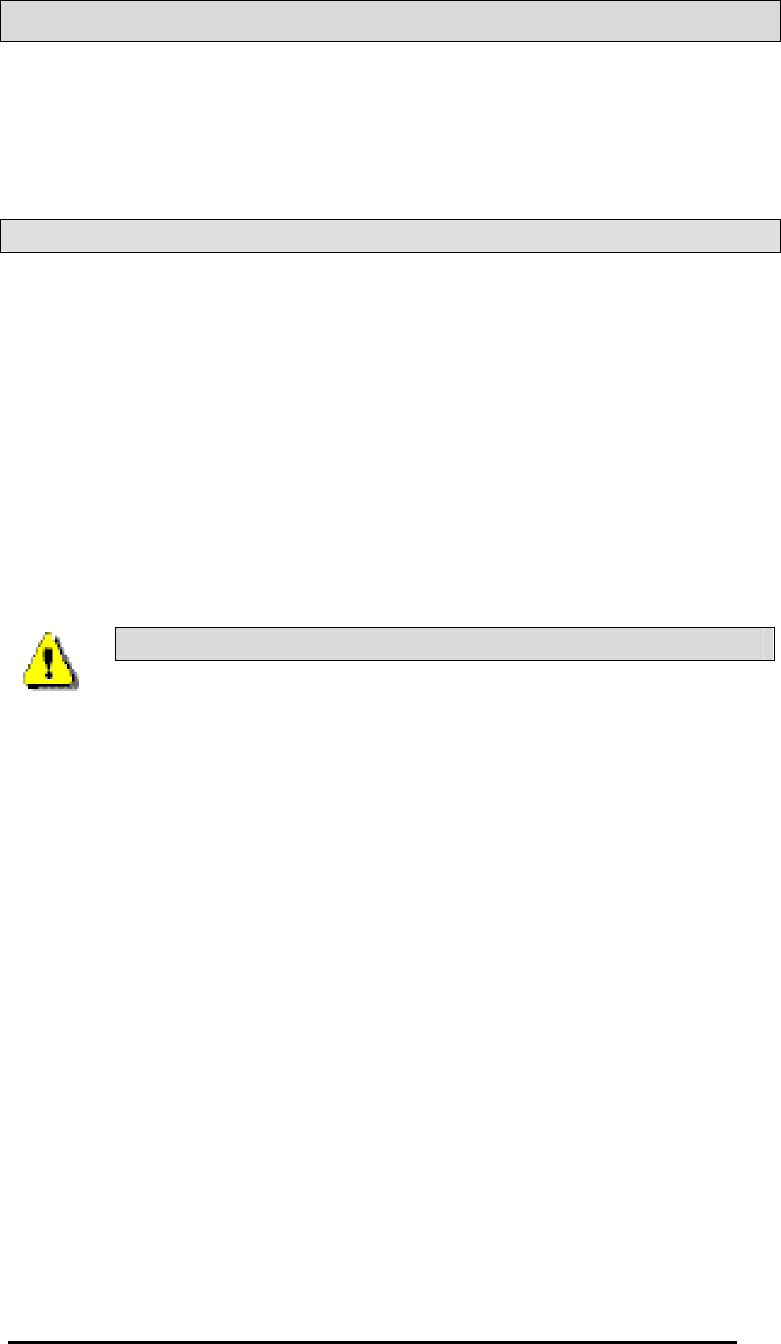
TriplePlay
User Manual 3
Version 1.0
Document #: BD-TU0001-10
General Information
The TriplePlay is a 3-in-1 router having the functions of a
standard ADSL router, plus voice capabilities and wireless
accessibility all in one box. Including three features adds
convenience and provides increased functions for one router.
Package Contents
Included in the package is one of each of the following—
•TriplePlay router
•AC power adapter
•USB cable
•RJ-11 telephone cable
•RJ-45 Ethernet cable
•Splitter
•User Manual
•Place your router on a flat surface close to the cables in a
location with sufficient ventilation.
•To prevent overheating, do not obstruct the ventilation
openings of this equipment.
•Plug this equipment into a surge protector to reduce the risk
of damage from power surges and lightning strikes.
•Operate this equipment only from an electrical outlet with
the correct power source as indicated on the adapter.
•Unplug equipment first before cleaning. A damp cloth can
be used to clean the equipment. Do not use liquid / aerosol
cleaners or magnetic / static cleaning devices.
•Do not open the cover of this equipment. Opening the
cover will void any warranties on the equipment.
Safety Instructions—Please read.
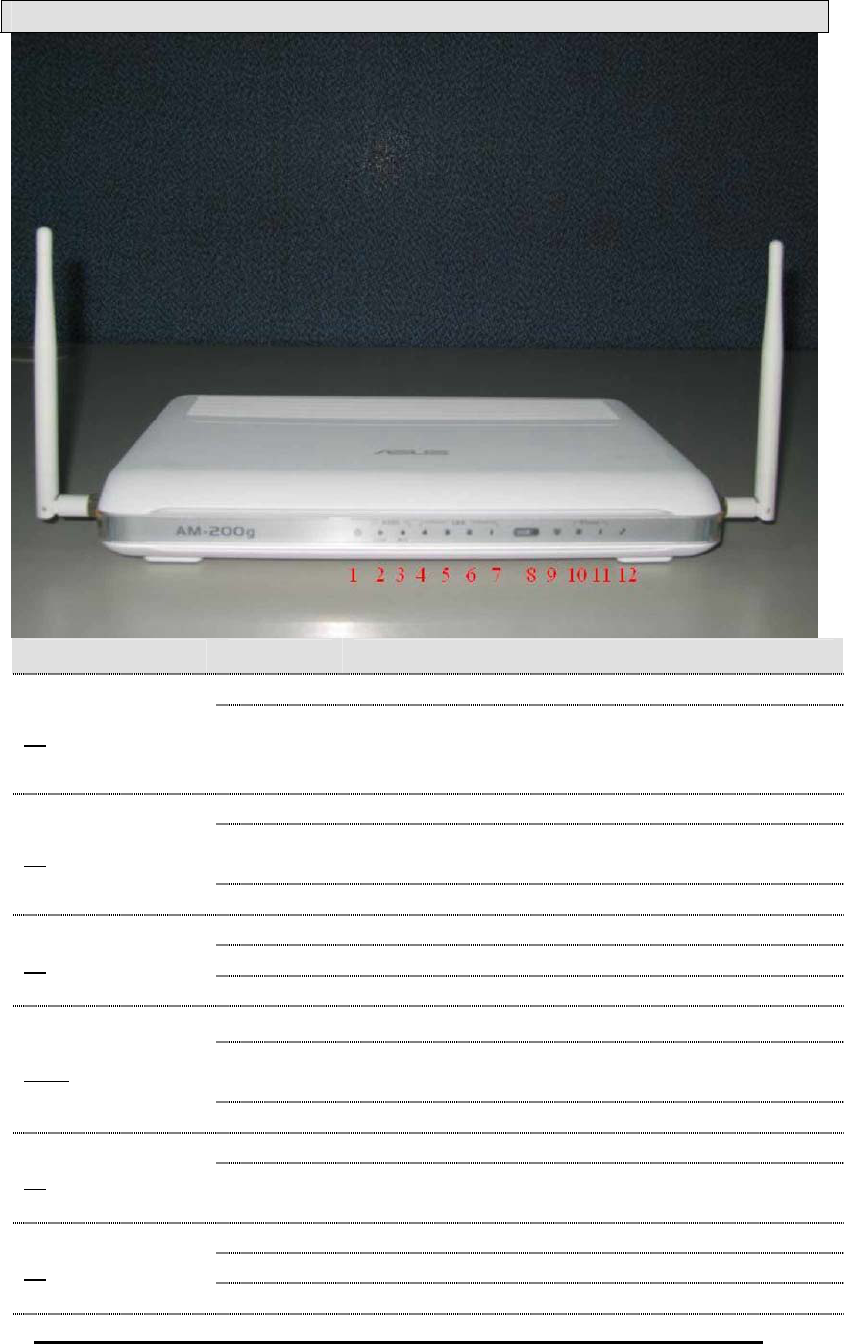
TriplePlay
User Manual 4
Version 1.0
Document #: BD-TU0001-10
Front Panel View
LED Mode Indication
Solid The router is on.
1. Power No light
The router is not on.
Check if the AC power adapter is
connected to the router and plugged in.
Solid ADSL is connected.
No light ADSL is not connected. ALARM LED will
be red.
2. ADSL / LINK
Blinking Router is connected to ADSL.
Solid ADSL is connected; no traffic.
3. ADSL / ACT No light ADSL is not connected.
Blinking Presence of ADSL traffic.
Solid Router is connected to LAN.
No light No connection to LAN. Check if LAN
cable is connected to router.
4-7. LAN 1-4
Blinking Presence of LAN traffic.
Solid Connection established using USB.
8. USB Device Flashing The router is sending or receiving data
using USB.
Solid Wireless is enabled.
No light Wireless is disabled.
9. Wi-Fi
Blinking Presence of wireless traffic.

TriplePlay
User Manual 5
Version 1.0
Document #: BD-TU0001-10
Solid Line2 is off-hook.
10. Phone2 No light Line2 is on-hook.
Solid Line1 is off-hook.
11. Phone1 No light Line1 is on-hook.
Solid Line is off-hook.
12. LINE No light Line is on-hook.
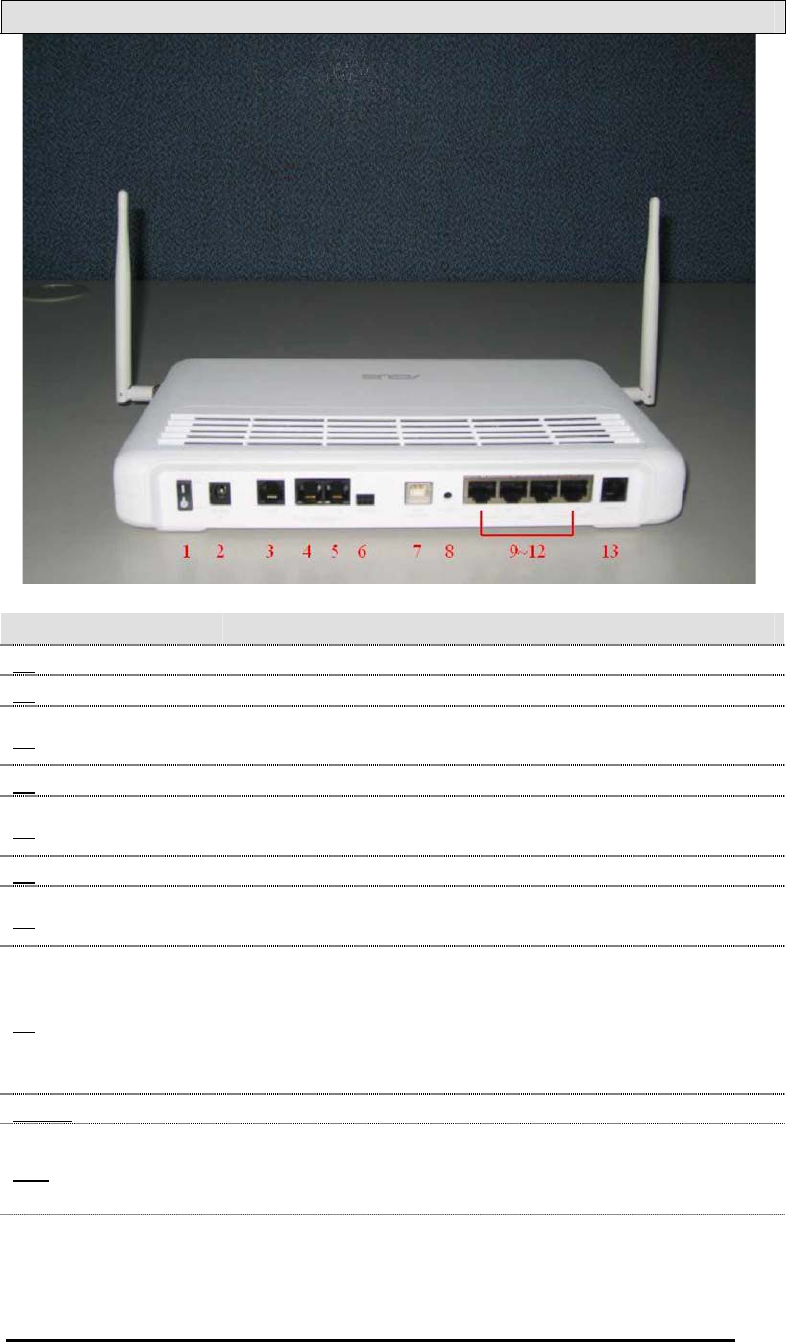
TriplePlay
User Manual 6
Version 1.0
Document #: BD-TU0001-10
Back Panel View
Port Description
1. On / Off Press to turn the router on and off.
2. DC 18V 1A Connects to the AC adapter.
3. LINE Connects to the wall outlet using an RJ-11
cable.
4. Phone1 Connects to a telephone using an RJ-11 cable.
5. Phone2 Connects to a second telephone using another
RJ-11 cable.
6. Console For professional use by service personnel only.
7. USB Device Optional: Use only if not using any of the LAN
lines.
8. Reset
Short reset (“system reboot”)—push & hold the
reset button for 4 seconds.
Long reset (“default settings”)—push the reset
button for more than 4 seconds and then
release.
9-12. LAN 1-4 Connect to PC(s) using RJ-45 cable(s).
13. ADSL
Connect to the splitter provided using an RJ-11
cable. Refer to the next page for complete
instructions for splitter connections.
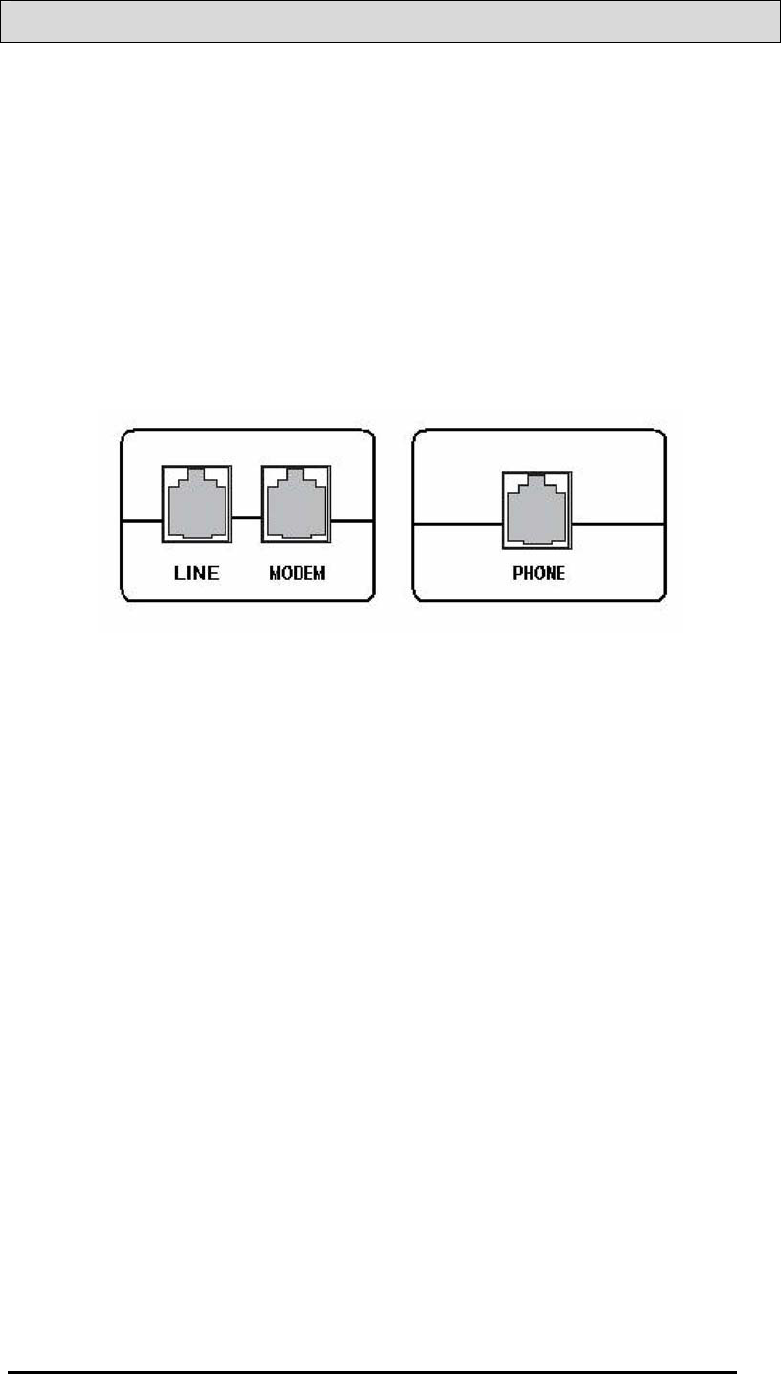
TriplePlay
User Manual 7
Version 1.0
Document #: BD-TU0001-10
Installing the Router
Connect the ADSL Line and Telephone
•Connect an RJ-11 cable between the wall phone jack and
the line-end of the splitter (see diagram below).
•Attach another RJ-11 phone wire to the modem-end of the
splitter and the ADSL port on the rear panel of the router.
•The phone-end of the splitter will be connected to the
telephone using a third RJ-11 phone wire.
NOTE: See connections on the installation diagram.
Connect the PC to the Router
By Ethernet—
•To use the Ethernet connection, connect the Ethernet cable
from the computer directly to the router.
•Connect one end of the Ethernet cable to the port(s)
labeled LAN 1-4 on the back of the router and attach the
other end to the Ethernet port of your computer.
By USB—
•Or, you can use the supplied USB cable to connect your
computer directly to the router.
•Connect one end of the USB cable to the USB port (labeled
USB Device) on the back of the router and connect the
other end to a free USB port on your PC.
•The Found New Hardware Wizard will open on your PC.
See USB Driver Installation below.

TriplePlay
User Manual 8
Version 1.0
Document #: BD-TU0001-10
•If your LAN has more than one computer, you can attach
one end of an Ethernet cable to a hub or a switch and the
other to the Ethernet port (labeled LAN) on the router. Note
that either a crossover or straight-through Ethernet cable
can be used. The router automatically recognizes the type
of connection that is required.
Connect a Printer or Server to the Router
If you have a printer or server that you wish to connect to the
router, attach the printer or server to the port labeled USB Host
using the USB cable that comes with the device.
Connect the Telephone to the Router
There are two ports on the back of your router labeled Phone 1
and Phone 2 for you to connect up to two telephones to. Use
RJ-11 cables to connect the telephone(s) to the router.
Connect the Router to a Phone Jack
•Before connecting the power adapter, connect the router
directly to a phone jack using an RJ-11 cable.
•Connect one end of an RJ-11 cable to the port labeled Line
on the back of the router and the other end to a wall phone
jack.
Connect the Power Adapter
•Complete the process by connecting the AC power adapter
to the POWER connector on the back of the device and
plug the adapter into a wall outlet or power strip.
•Then turn on and boot up your PC and any LAN devices,
such as hubs or switches, and any computers connected to
them.
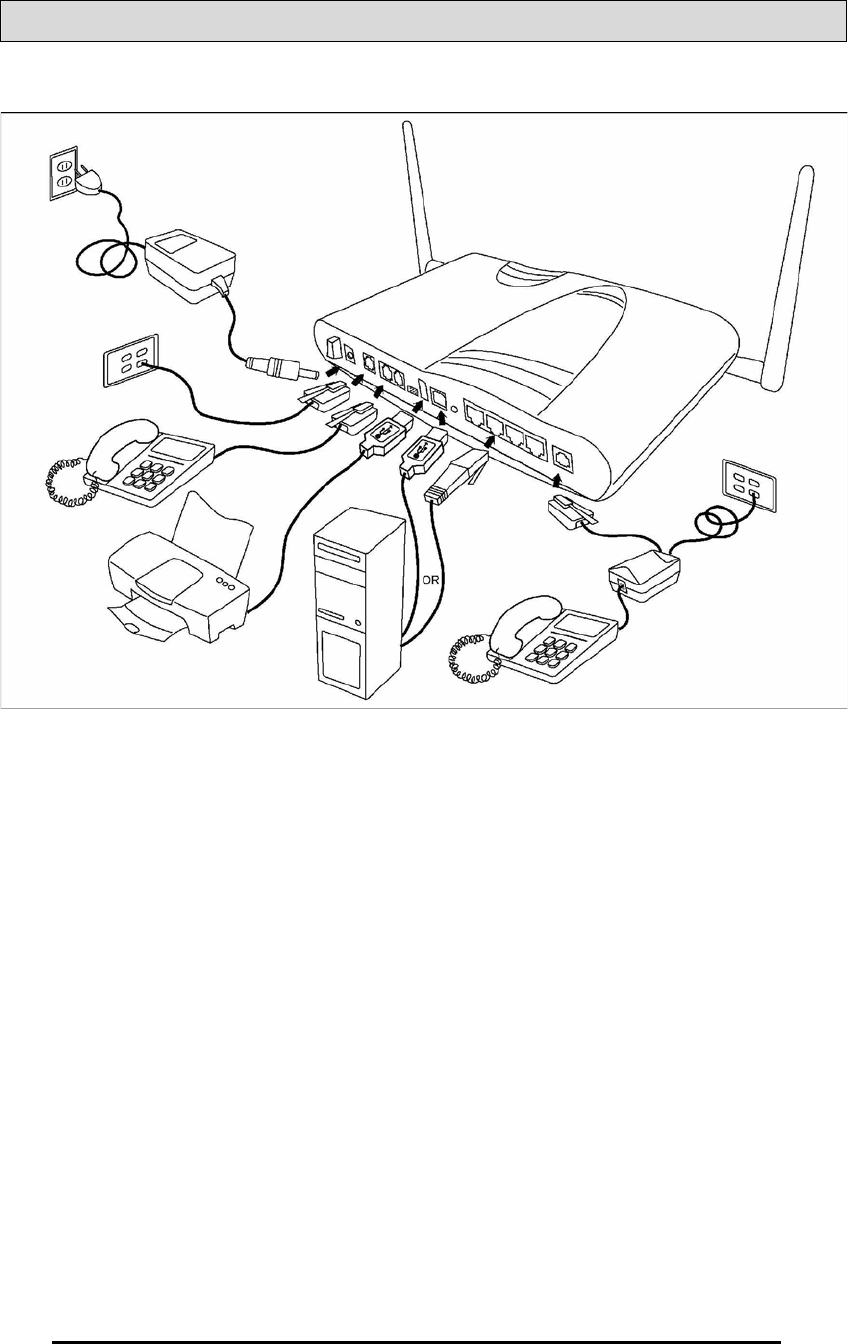
TriplePlay
User Manual 9
Version 1.0
Document #: BD-TU0001-10
Installation Diagram
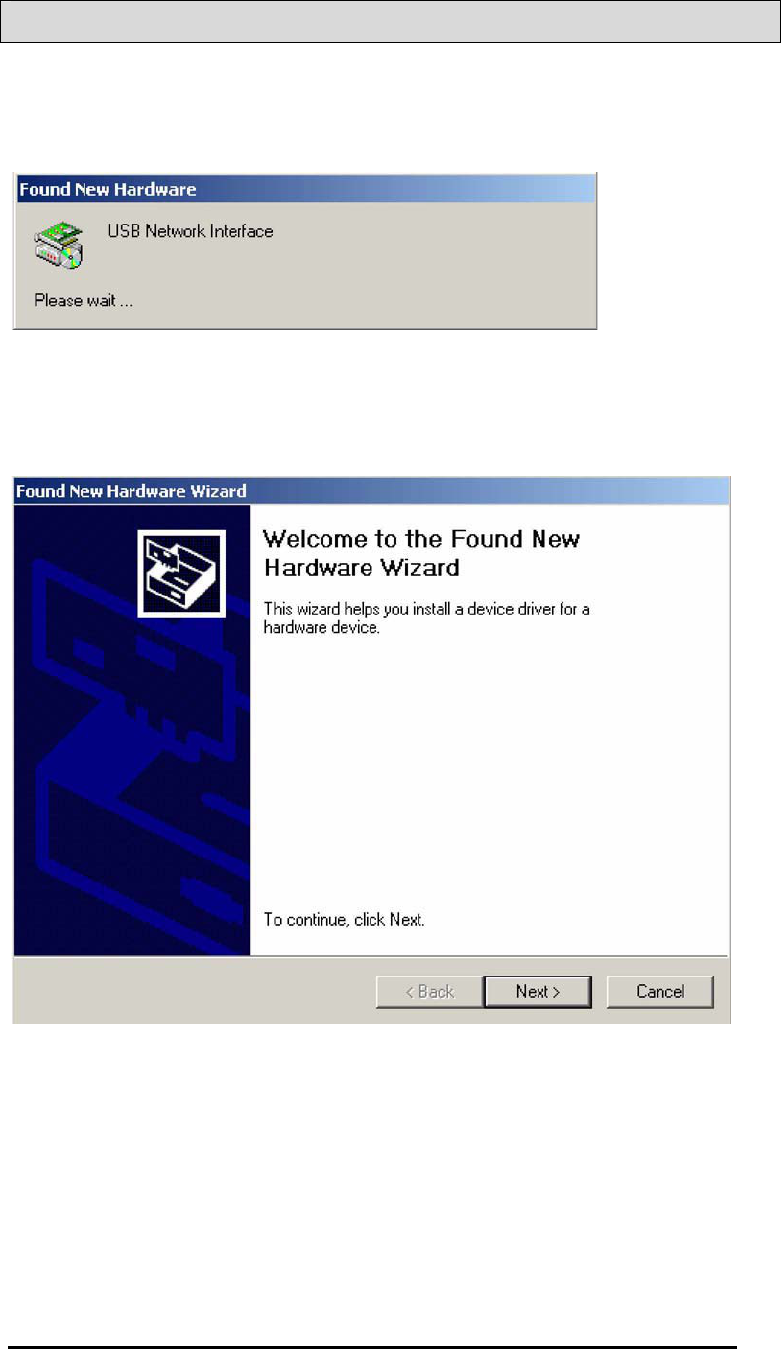
TriplePlay
User Manual 10
Version 1.0
Document #: BD-TU0001-10
USB Driver Installation
The following instructions will guide you through the installation of
the USB driver.
1. When you attach the USB cable to the router for the first time
and turn on the device, Windows will detect new hardware
and the Found New Hardware Wizard will appear.
2. The Found New Hardware Wizard will appear shortly after,
identifying that a USB driver is needed. Click on Next to
continue with the installation.
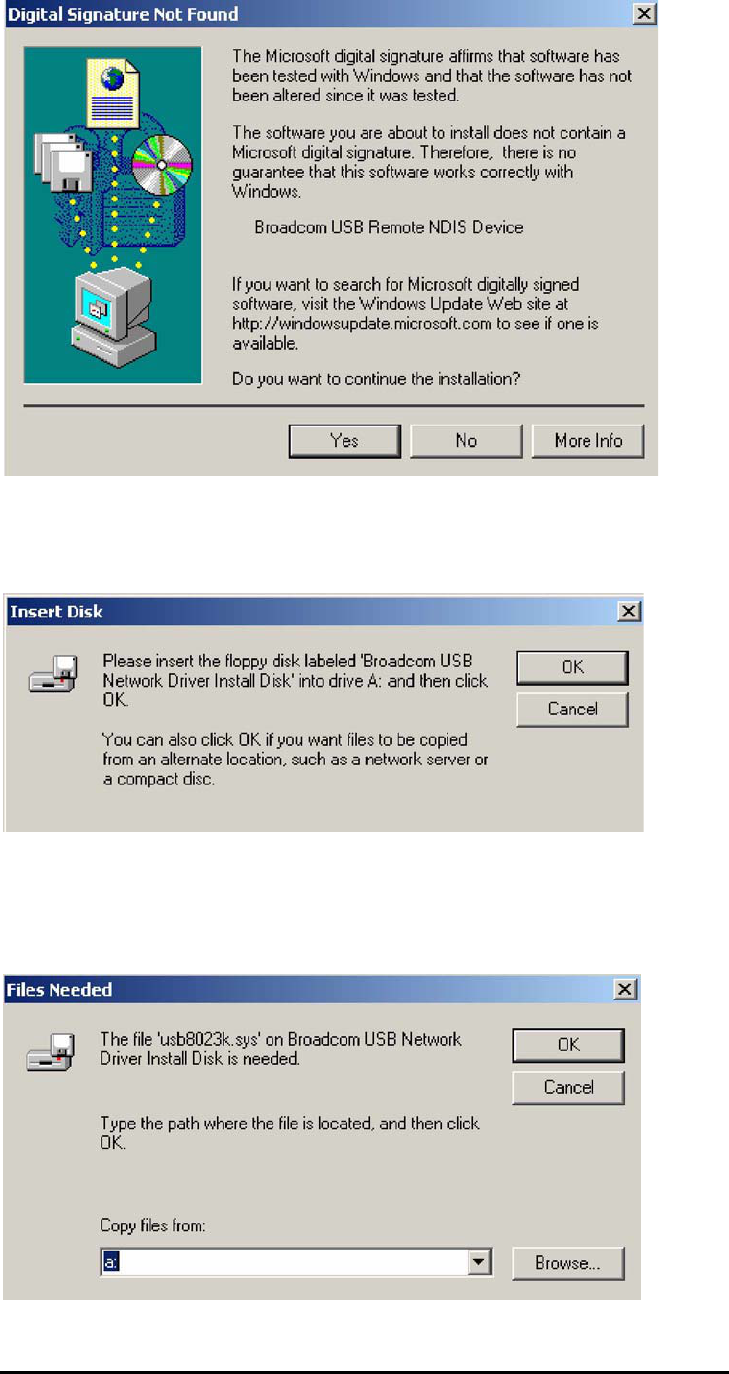
TriplePlay
User Manual 11
Version 1.0
Document #: BD-TU0001-10
3. The Digital Signature Not Found window appears. Click
Yes to continue with the installation.
4. Then the Insert Disk window prompts you to insert the disk
(or CD) containing the USB driver. Click OK after inserting
the disk (or CD).
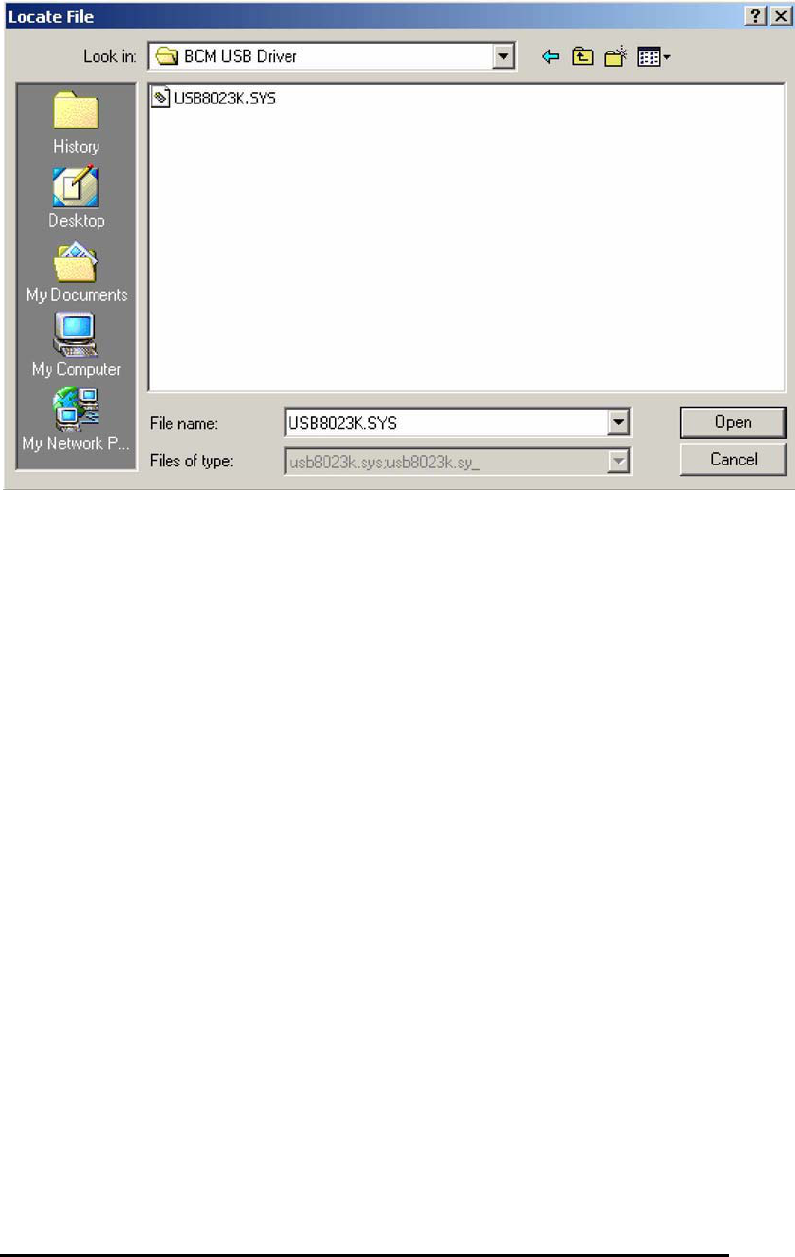
TriplePlay
User Manual 12
Version 1.0
Document #: BD-TU0001-10
5. After clicking OK at the previous window, you will be asked to
browse for the location of the disk (or CD) that the USB driver is
on. Then click OK to continue to the next step.
6. When you select the location of the disk (or CD), the required file
USB8023K.SYS will automatically be updated in the filename
window of this screen. Click on Open to continue with the
installation process.

TriplePlay
User Manual 13
Version 1.0
Document #: BD-TU0001-10
7. The last window lets you know that the driver installation is
complete. Click Finish to close the wizard.

TriplePlay
User Manual 14
Version 1.0
Document #: BD-TU0001-10
Configuring Your Computer
Prior to accessing the router through the LAN or the USB port,
note the following necessary configurations—
•Your PC’s TCP/IP address: 192.168.1.__( the last number
is any number between 3 and 254)
•The router’s default IP address: 192.168.1.1
•Subnet mask: 255.255.255.0
Below are the procedures for configuring your computer. Follow
the instructions for the operating system that you are using.
Windows 2000
1. In the Windows taskbar, click on the Start button and point
to Settings, Control Panel, and Network and Dial-up
Connections (in that order).
2. Click on Local Area Connection. When you have the Local
Area Connection Status window open, click on Properties.
3. Listed in the window are the installed network components.
If the list includes Internet Protocol (TCP/IP), then the
protocol has already been enabled, and you can skip to
Step 10.
4. If Internet Protocol (TCP/IP) does not appear as an
installed component, then click on Install.
5. In the Select Network Component Type window, click on
protocol and then the Add button.
6. Select Internet Protocol (TCP/IP) from the list and then click
on OK.
7. If prompted to restart your computer with the new settings,
click OK.

TriplePlay
User Manual 15
Version 1.0
Document #: BD-TU0001-10
8. After your computer restarts, click on the Network and Dial-
up Connections icon again, and right click on the Local
Area Connection icon and then select Properties.
9. In the Local Area Connection Properties dialog box, select
Internet Protocol (TCP/IP) and then click on Properties.
10. In the Internet Protocol (TCP/IP) Properties dialog box,
click in the radio button labeled Use the following IP
address and type 192.168.1.x (where x is any number
between 2 and 254) and 255.255.255.0 in the IP address
field and Subnet Mask field.
11. Click on OK twice to save your changes and then close
the Control Panel.
Windows XP
1. In the Windows taskbar, click on the Start button and point
to Settings and then click Network Connections.
2. In the Network Connections window, right click on the Local
Area Connection icon and click on properties.
3. Listed in the Local Area Connection window are the
installed network components. Make sure the box for
Internet Protocol (TCP/IP) is checked and then click on
Properties.
4. In the Internet Protocol (TCP/IP) Properties dialog box, click
in the radio button labeled Use the following IP address and
type 192.168.1.x (where x is any number between 2 and
254) and 255.255.255.0 in the IP address field and Subnet
Mask field.
5. Click on OK twice to save your changes and then close the
Control Panel.
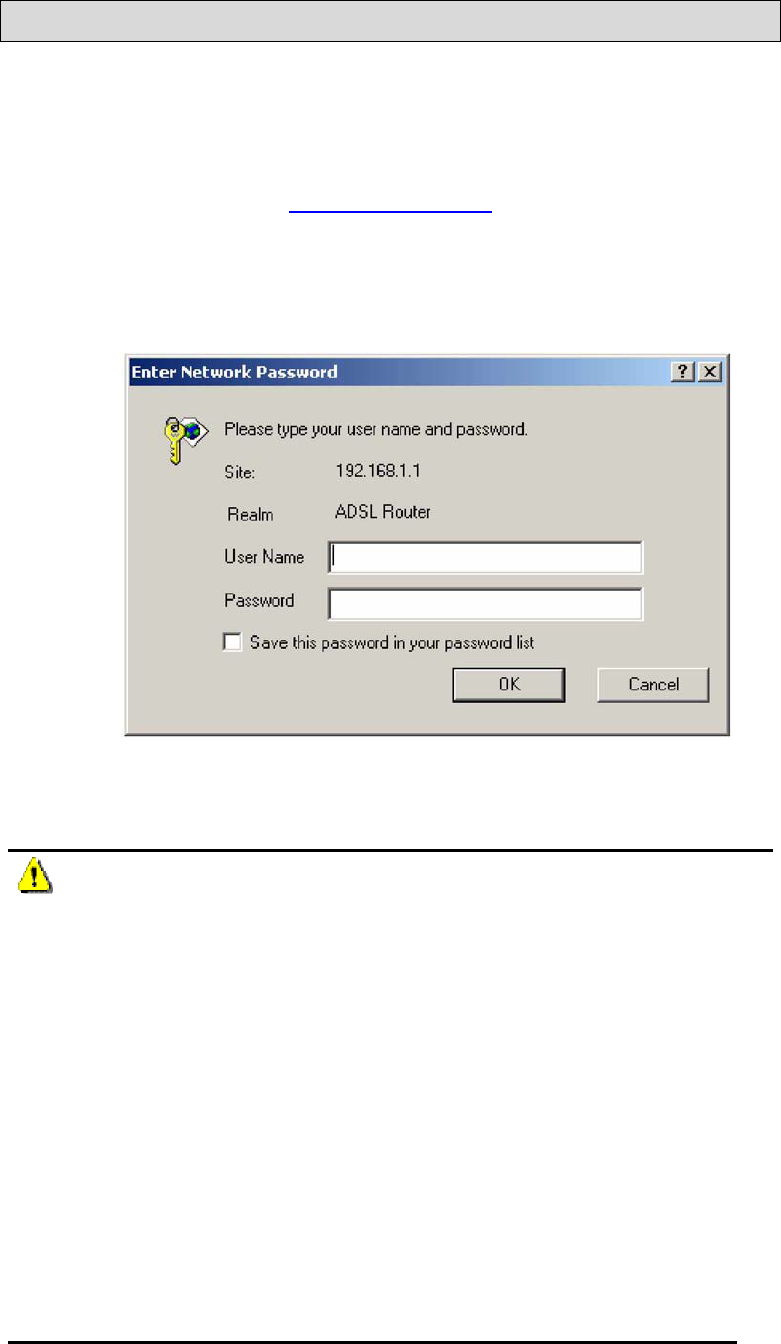
TriplePlay
User Manual 16
Version 1.0
Document #: BD-TU0001-10
Log in to the Router
This section will explain how to log in to your router using the
following steps—
1. Launch your web browser.
2. Enter the URL http://192.168.1.1 in the address bar and
press Enter.
A login screen like the one below will be displayed after you
connect to the user interface.
3. Enter your user name and password, and then click on
OK to display the user interface.
NOTE: There are two default user name and password
combinations. The user / user name and password combination
can display device status, but cannot change or save
configurations. The admin / admin combination can perform all
functions. Passwords can be changed at any time. Please note
that this user manual is based on the admin / admin login which
includes all functions.
____________________________________________________
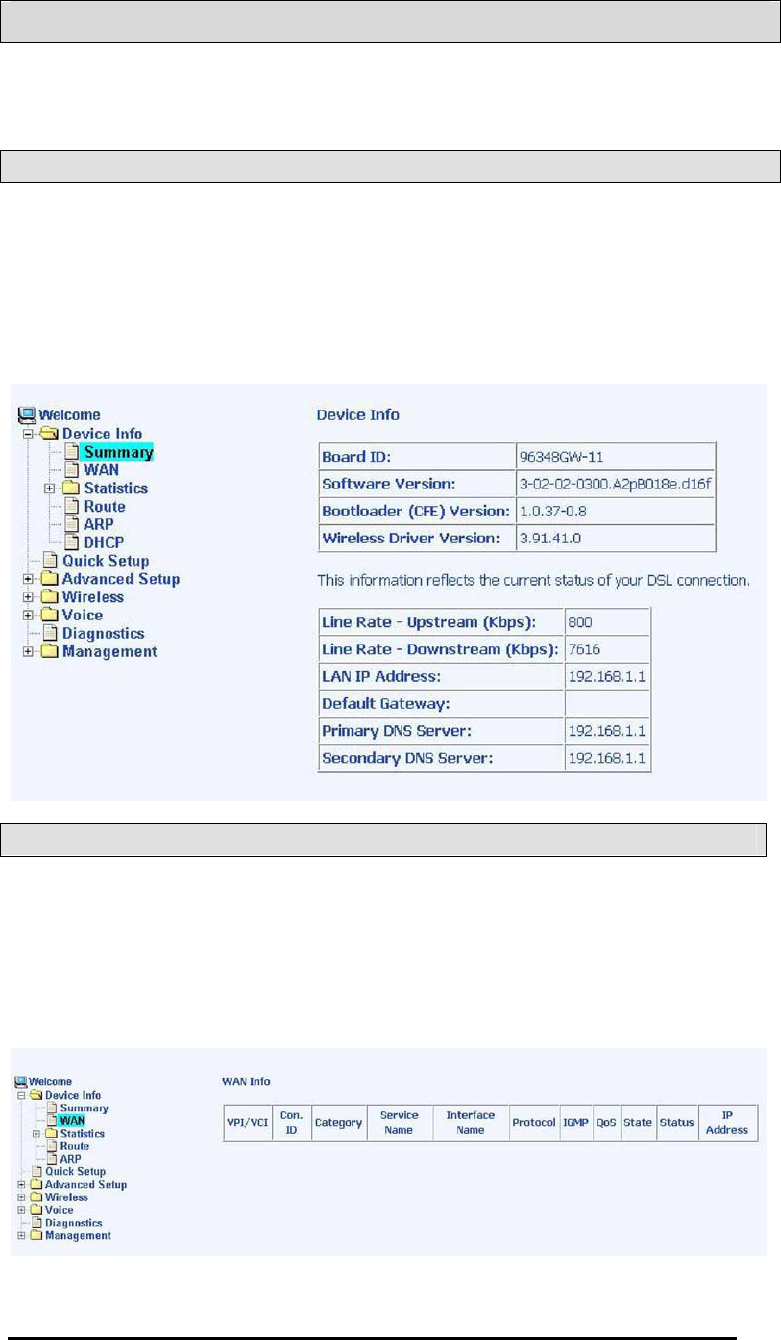
TriplePlay
User Manual 17
Version 1.0
Document #: BD-TU0001-10
This section describes the system information that can be
accessed using the menu items under Device Info.
Summary
Access the general information of the router by clicking on
“Summary” under “Device Info”. It shows details of the router
such as software version, wireless driver version, LAN IP address,
etc. It also displays the current status of your DSL connection as
shown below—
WAN
Access the WAN status report from the router by clicking on
“WAN” under “Device Info”. Since a WAN connection has not
been set up yet, there is no information to view. After completing
the configurations for a WAN connection, you can return to this
screen to view the information on your WAN status.
Device Info
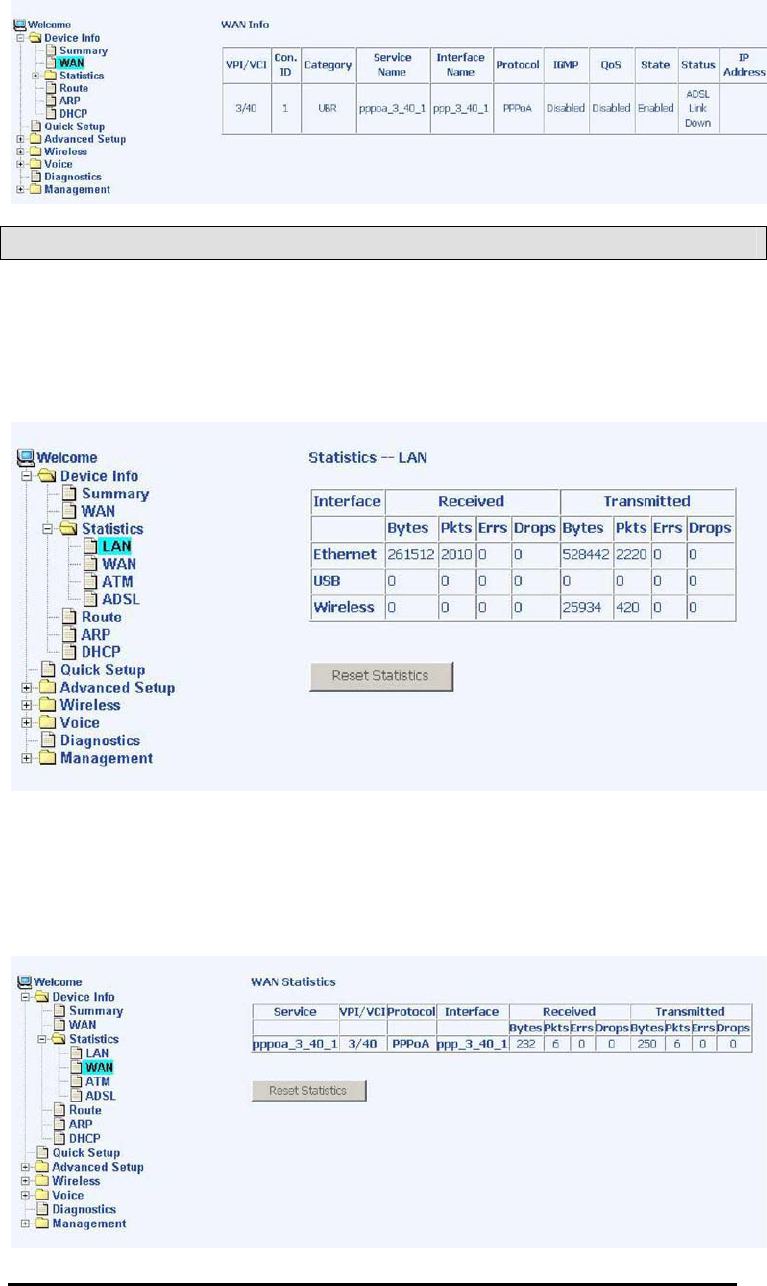
TriplePlay
User Manual 18
Version 1.0
Document #: BD-TU0001-10
Below is how the screen will look once a WAN connection is set
up.
Statistics
LAN Statistics
Access the LAN statistics from the router by clicking on the “LAN”
item under “Statistics”
WAN Statistics
Access the WAN statistics from the router by clicking on the
“WAN” item under “Statistics”.
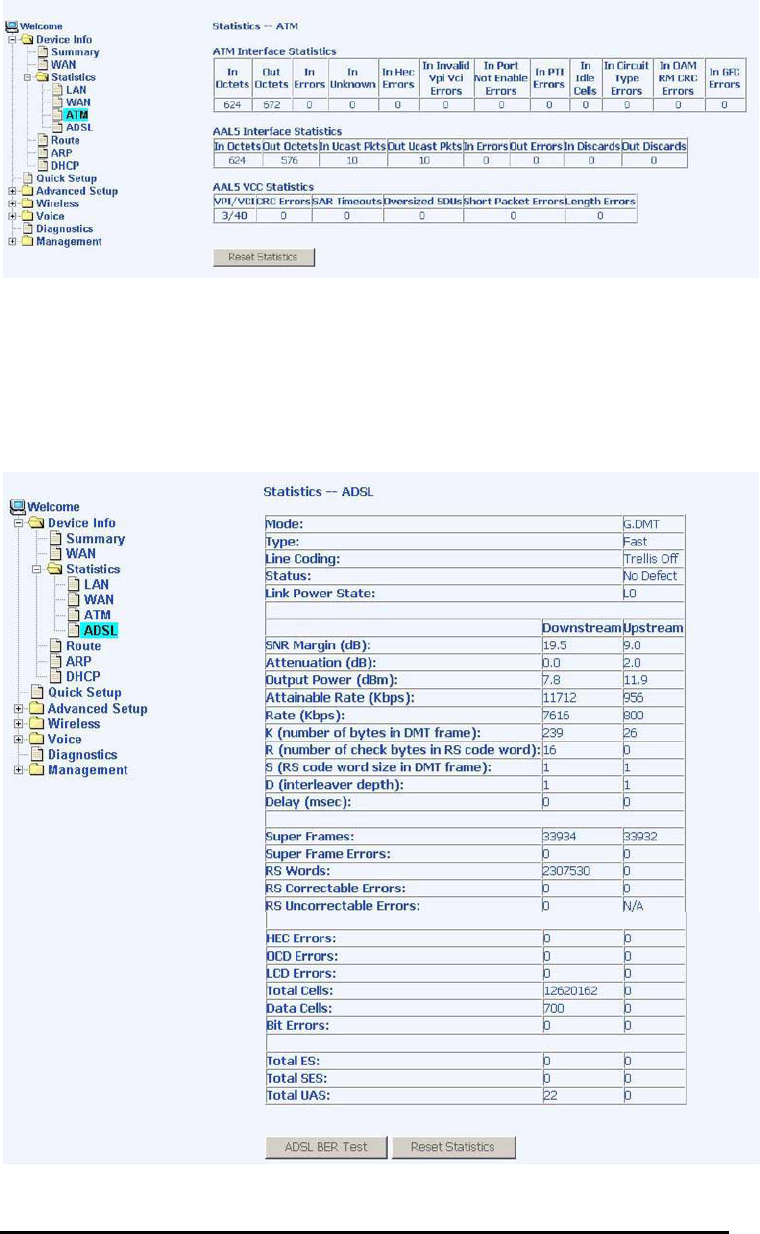
TriplePlay
User Manual 19
Version 1.0
Document #: BD-TU0001-10
ATM Statistics
Access ATM statistics from the router by clicking on the “ATM”
item under “Statistics”.
ADSL Statistics
You can view ADSL statistics by clicking on the “ADSL” item
under “Statistics”. Information contained in this screen is useful
for troubleshooting and diagnostics of connection problems.
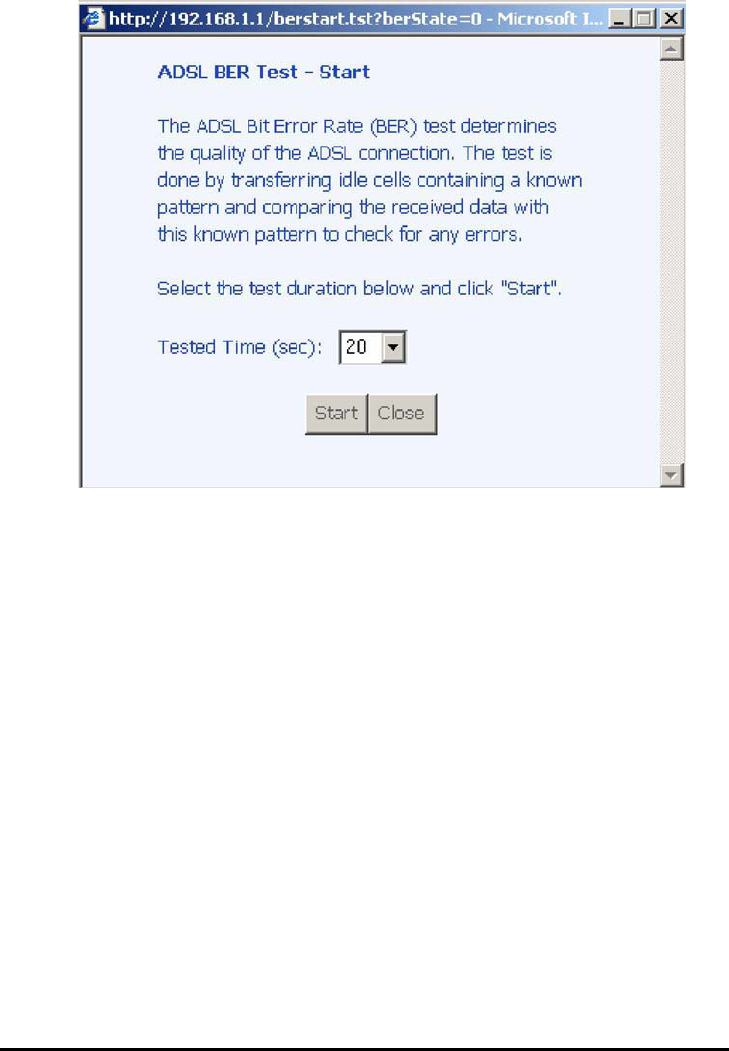
TriplePlay
User Manual 20
Version 1.0
Document #: BD-TU0001-10
ADSL BER Test
A Bit Error Rate Test (BER Test) is a test that reflects the ratio of
error bits to the total number transmitted.
If you click on the ADSL BER Test button at the bottom of the
ADSL Statistics screen, the following pop-up screen will appear
allowing you to set the tested time and to begin the test.
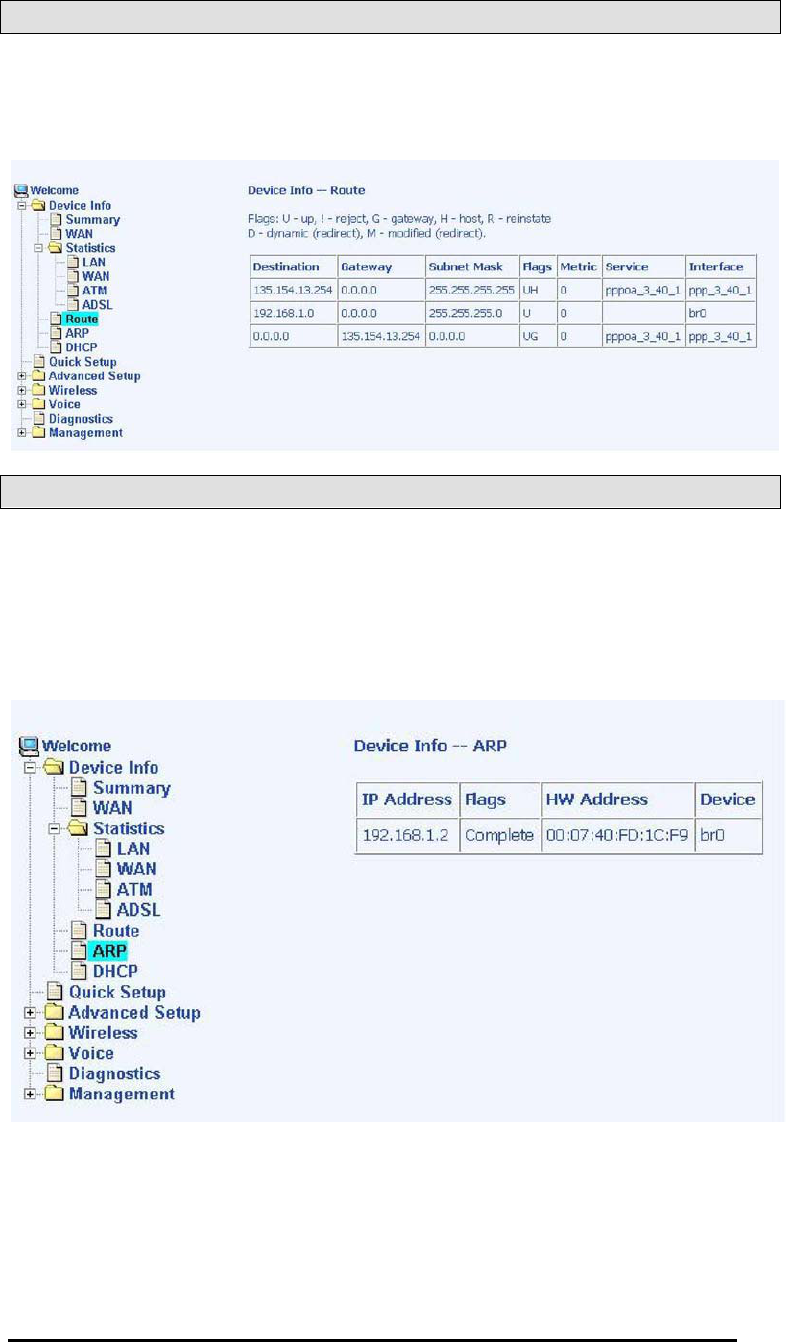
TriplePlay
User Manual 21
Version 1.0
Document #: BD-TU0001-10
Route
Access the routing status report from the router by clicking on the
“Route” item under “Device Info”.
ARP
Access the ARP status report from the router by clicking on the
“ARP” item under “Device Info”. ARP (Address Resolution
Protocol) maps the IP address to the physical address, labeled
HW Address (the MAC address) and helps to identify computers
on the LAN.
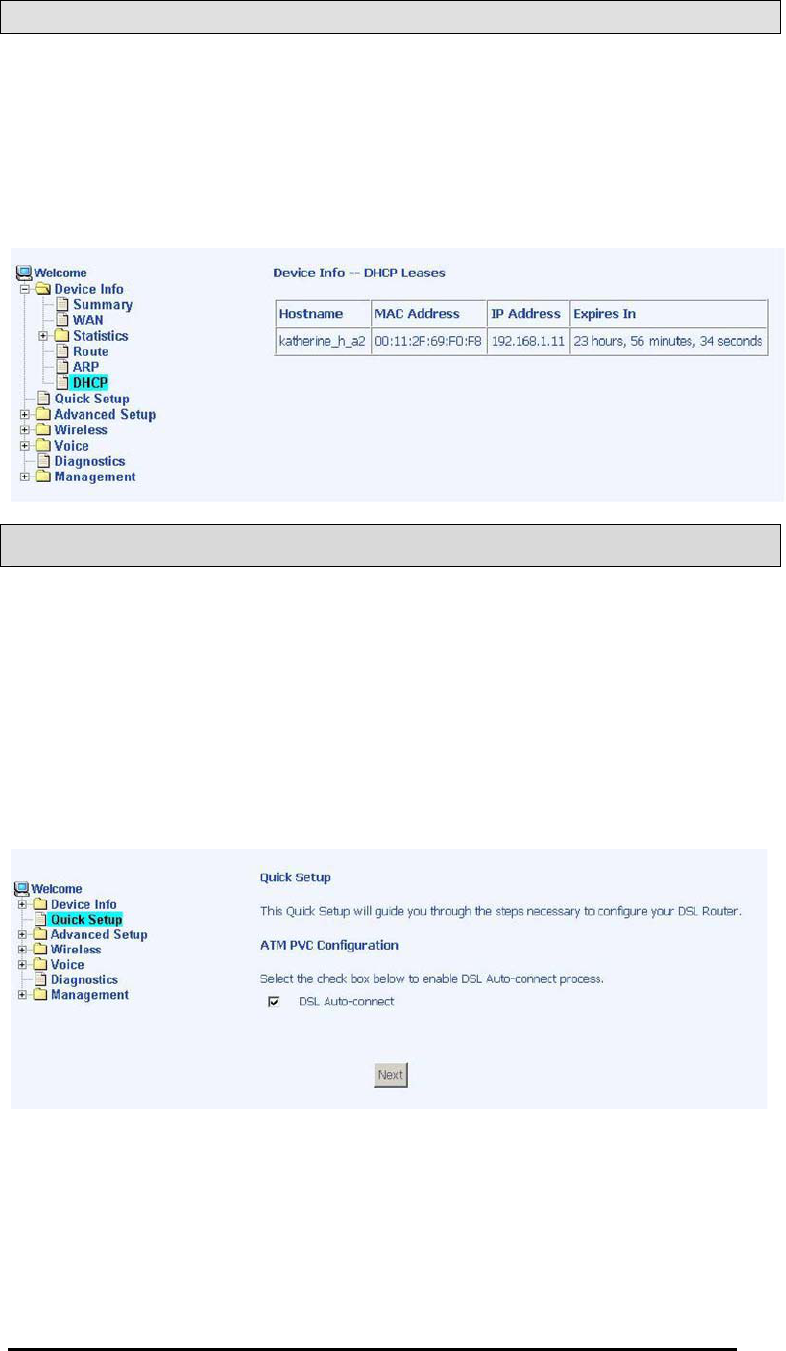
TriplePlay
User Manual 22
Version 1.0
Document #: BD-TU0001-10
DHCP
Access the DHCP Leases screen by clicking “DHCP” under
“Statistics”. This shows the computers, identified by the
hostname and MAC address that have acquired IP addresses by
the DHCP server with the time that the lease for the IP address is
up.
Quick Setup
This section will explain how to quickly configure the router for the
single purpose of connecting to the Internet.
To enable the auto-connect process, click on the box labeled DSL
Auto-connect, a process that will automatically detect the first
usable PVC and automatically detect PPPoE, PPPoA, and Bridge
Protocol (with DHCP Server available). To continue, click on the
Next button.
If you uncheck the DSL Auto-connect box, the resulting screen is
seen below. Enter the VPI / VCI as indicated by your ISP and
enable Quality of Service to enable the function. To continue,
click on Next.
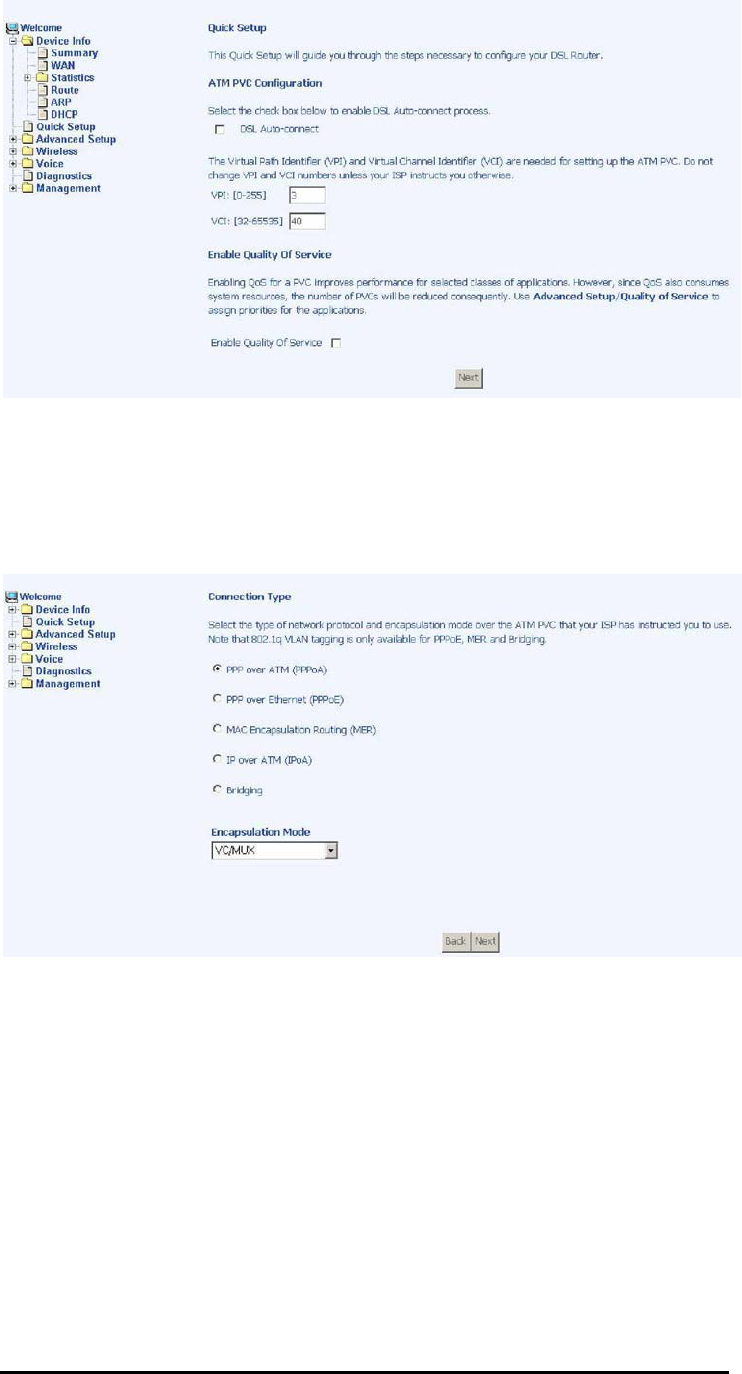
TriplePlay
User Manual 23
Version 1.0
Document #: BD-TU0001-10
Following is the Connection Type screen where you select the
type of network protocol and encapsulation mode over the ATM
PVC that your ISP has instructed you to use. The following is a
PPPoA example. Click on Next to continue.
Enter the PPP username and password as given by your ISP.
Then decide if you will be using any features such as dial on
demand, PPP IP extension, keep alive and then click on Next.
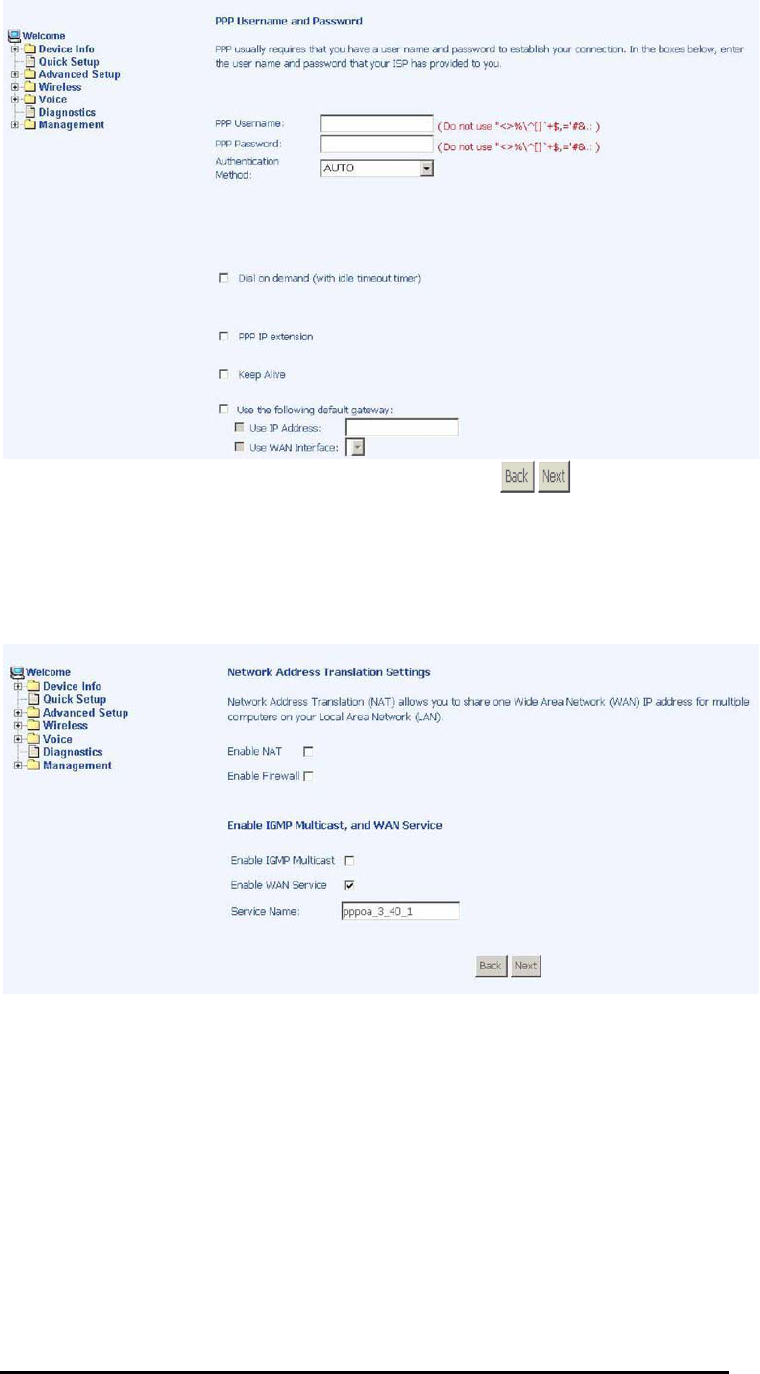
TriplePlay
User Manual 24
Version 1.0
Document #: BD-TU0001-10
The next step is to configure the Network Address Translation
(NAT) settings. Enable the necessary services and then click on
Next to continue.
You can configure the DSL Router IP address and Subnet Mask
for the LAN interface to correspond to your LAN’s IP Subnet. If
you want the DHCP server to automatically assign IP addresses,
then enable the DHCP server and enter the range of IP addresses
that the DHCP server can assign to your computers. Disable the
DHCP server if you would like to manually assign IP addresses.
Click on Next to continue.
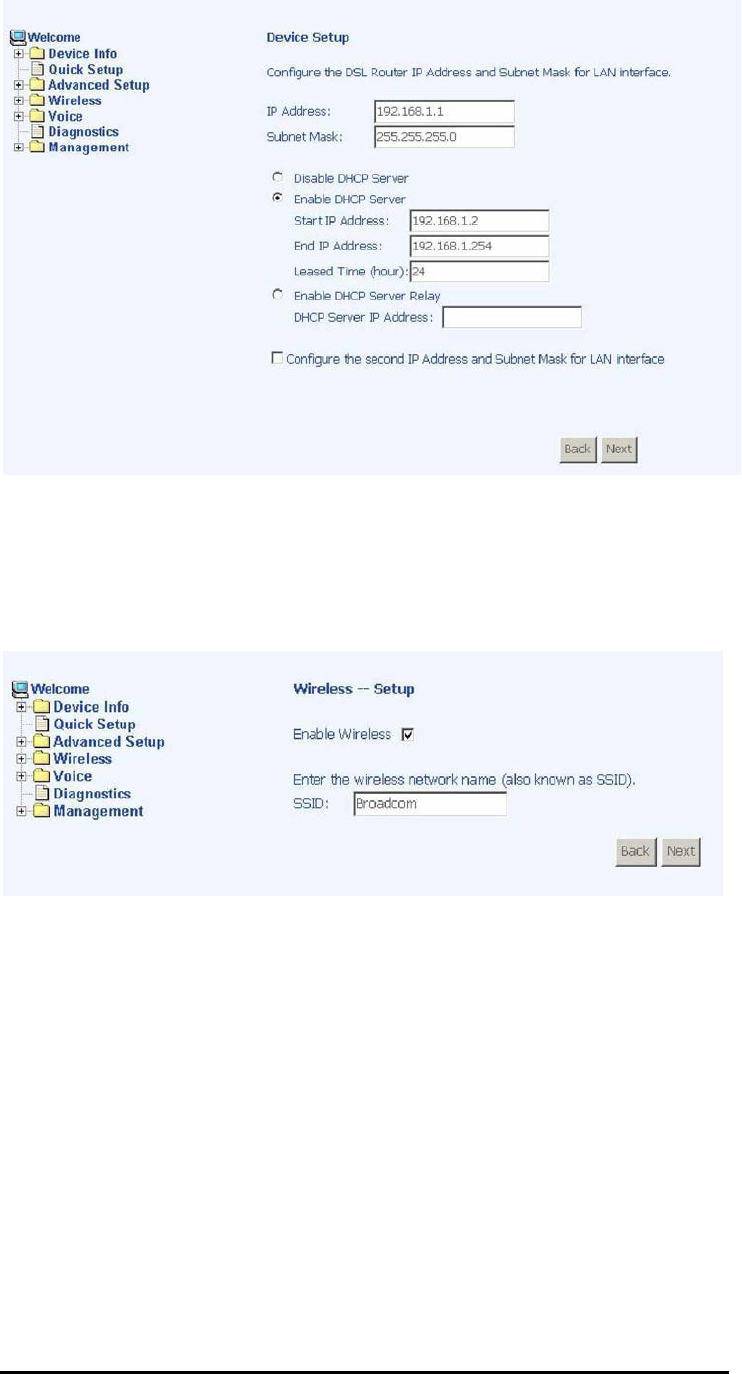
TriplePlay
User Manual 25
Version 1.0
Document #: BD-TU0001-10
The next screen allows you to enable / disable the wireless
function. If you enable wireless, then enter the wireless network
name (SSID). The default SSID—Broadcom—is already entered.
Click on Next to continue.
After all of the WAN configurations have been made, the WAN
Setup Summary screen displays all WAN settings that you have
made. Check that the settings are correct before clicking on the
Save / Reboot button. Clicking on Save / Reboot will save your
settings and restart your router.
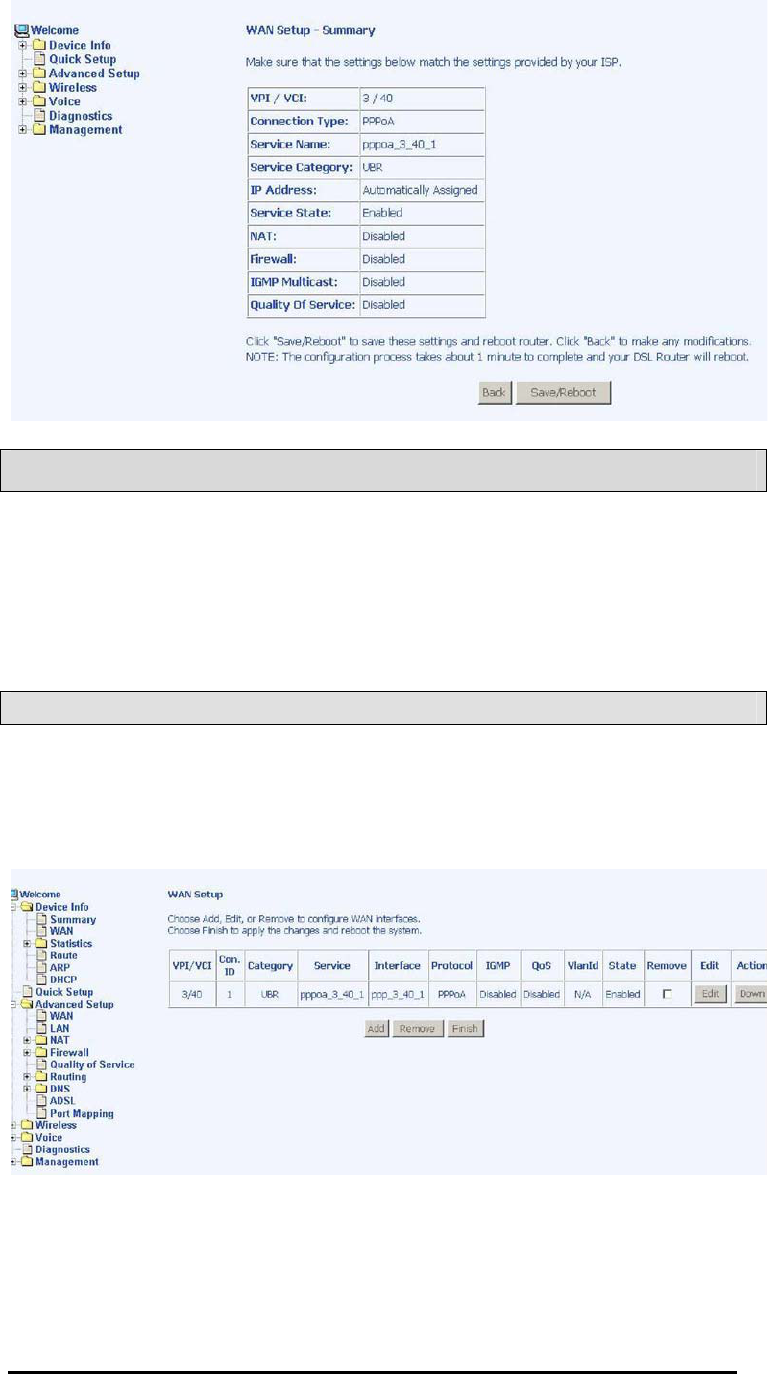
TriplePlay
User Manual 26
Version 1.0
Document #: BD-TU0001-10
Advanced Setup
This section of the setup is an advanced version of the quick
setup. If you want to make specific configurations to your router
such as firewall, port mapping, quality of service, DNS, etc.,
consider going through this advanced setup for a more
comprehensive configuration.
WAN
Configure the WAN settings as provided by your ISP. The
following screen shows the PPPoA connection that was
established in the previous Quick Setup example.
Click on the Add button if you want to add a new connection for
the WAN interface. The ATM PVC Configuration screen is seen
below. The ATM PVC Configuration screen allows you to
configure an ATM PVC identifier (VPI and VCI) and select a
service category.
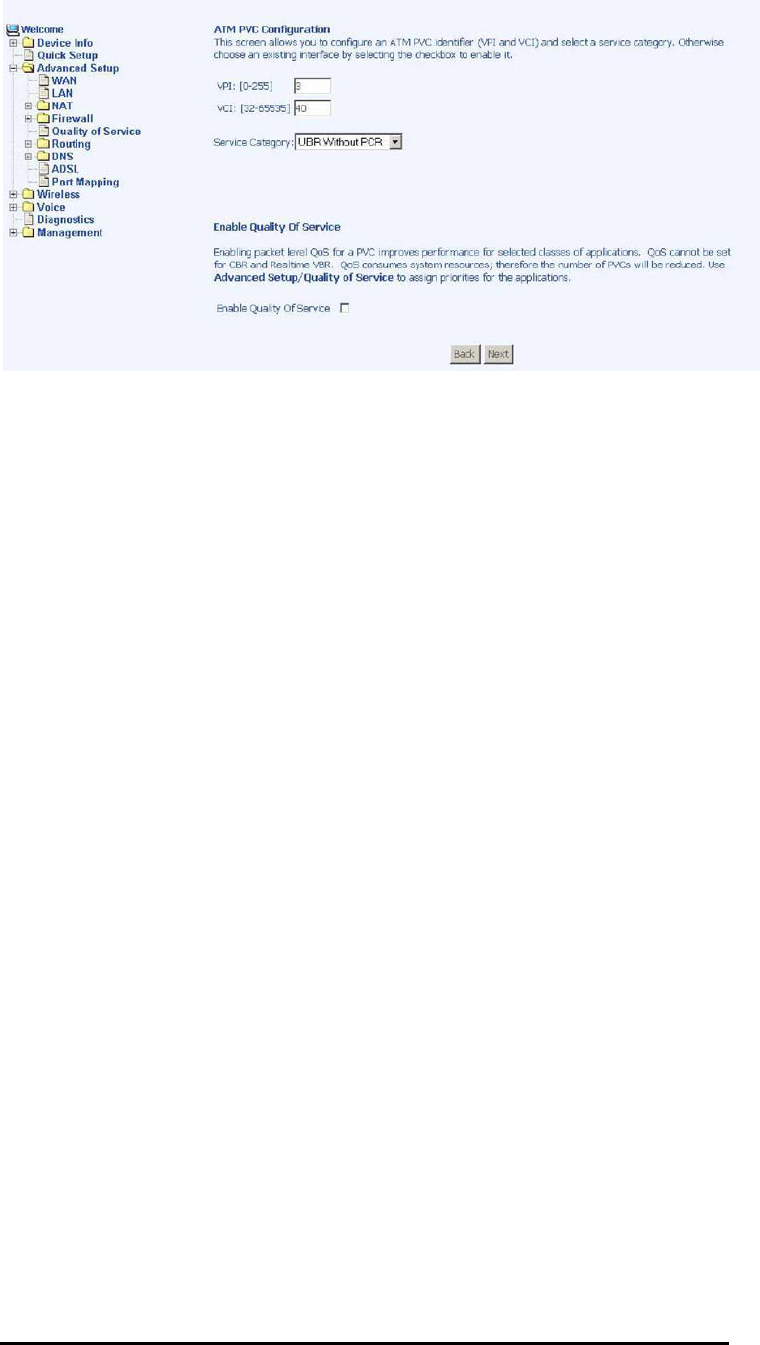
TriplePlay
User Manual 27
Version 1.0
Document #: BD-TU0001-10
Find out the following values from your ISP before you change
them.
•VPI : Virtual Path Identifier. The valid range is 0 to 255.
•VCI : Virtual Channel Identifier. The valid range is 32 to
65535.
•Service Category : Five classes of traffic are listed—
oUBR Without PCR (Unspecified Bit Rate without
Peak Cell Rate)—UBR service is suitable for
applications that can tolerate variable delays and
some cell losses. Applications suitable for UBR
service include text/data/image transfer, messaging,
distribution, and retrieval and also for remote terminal
applications such as telecommuting.
oUBR With PCR (Unspecified Bit Rate with Peak Cell
Rate)
oCBR (Constant Bit Rate)—used by applications that
require a fixed data rate that is continuously available
during the connection time. It is commonly used for
uncompressed audio and video information such as
videoconferencing, interactive audio (telephony),
audio / video distribution (e.g. television, distance
learning, and pay-per-view), and audio / video
retrieval (e.g. video-on-demand and audio library).
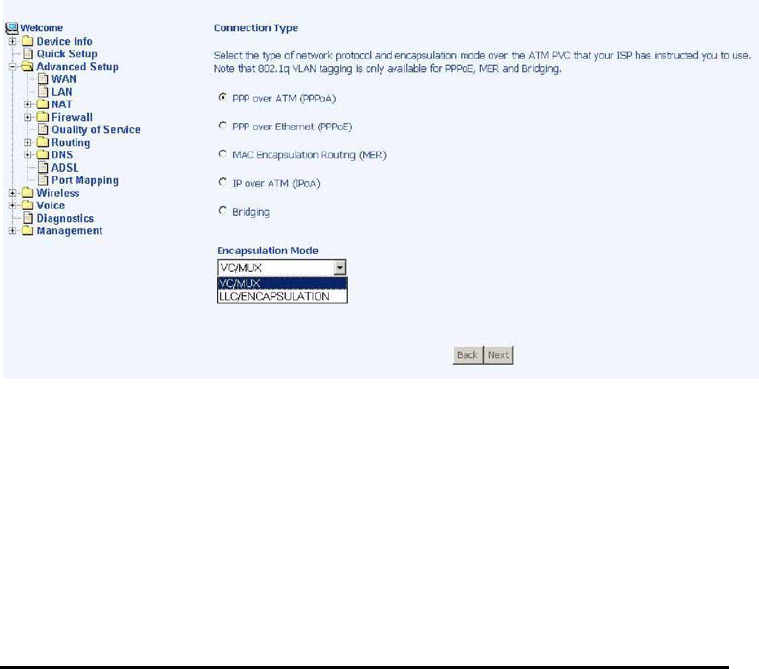
TriplePlay
User Manual 28
Version 1.0
Document #: BD-TU0001-10
oNon Realtime VBR (Non-Real-time Variable Bit
Rate)—can be used for data transfers that have
critical response-time requirements such as airline
reservations, banking transactions, and process
monitoring.
oRealtime VBR (Real-time Variable Bit Rate)—used by
time-sensitive applications such as real-time video.
Rt-VBR service allows the network more flexibility
than CBR.
The next screen shows the below types of network protocols and
encapsulation modes—
•PPP over ATM (PPPoA)
•PPP over Ethernet (PPPoE)
•MAC Encapsulation Routing (MER)
•IP over ATM (IpoA)
•Bridging
Select the mode that your ISP has instructed you to use and click
on Next.
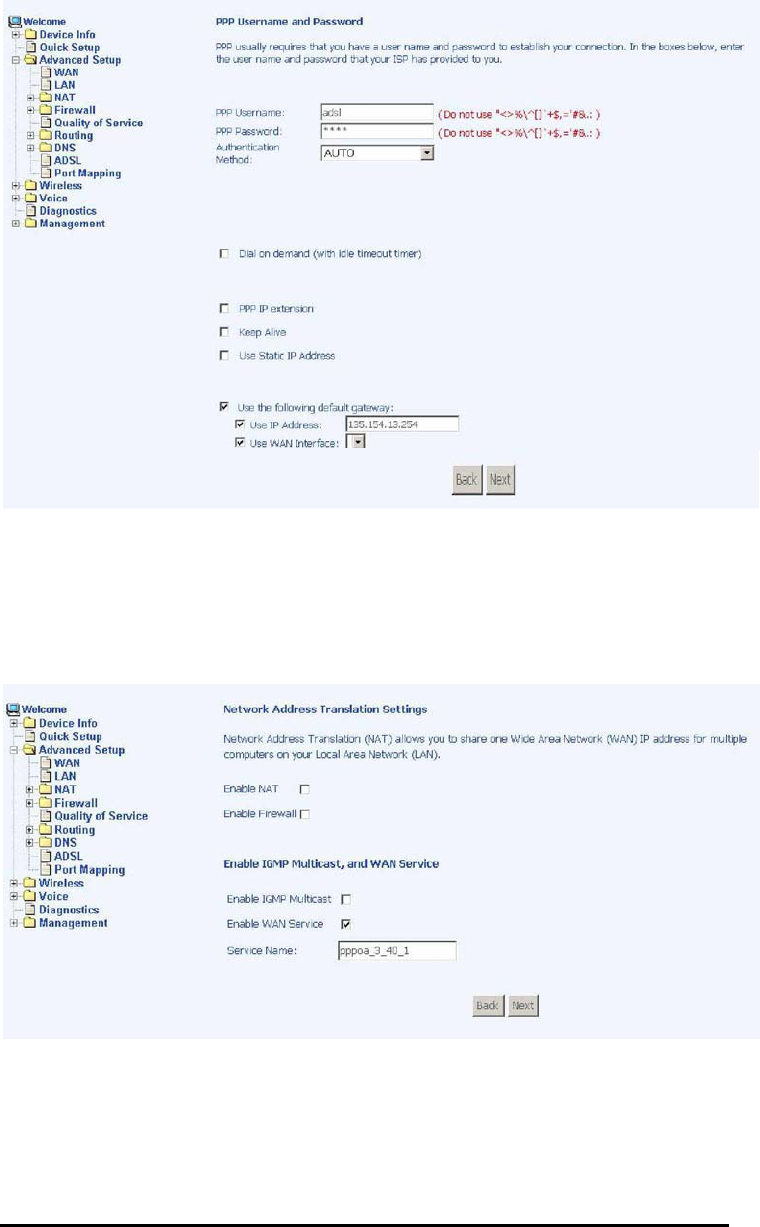
TriplePlay
User Manual 29
Version 1.0
Document #: BD-TU0001-10
Since this example uses a PPPoA connection, the next screen
requires you to enter a PPP username and password. After filling
in the page and making any selections your ISP has instructed
you to, click on Next to continue.
The next screen allows you to configure NAT either by enabling or
disabling it. Other services include IGMP multicast and WAN
service. After making your selections, click on Next to go on to
the next page.
When the settings are complete, the next screen shows a WAN
Setup – Summary screen displaying the WAN configurations
made. Click on Save to save the settings.
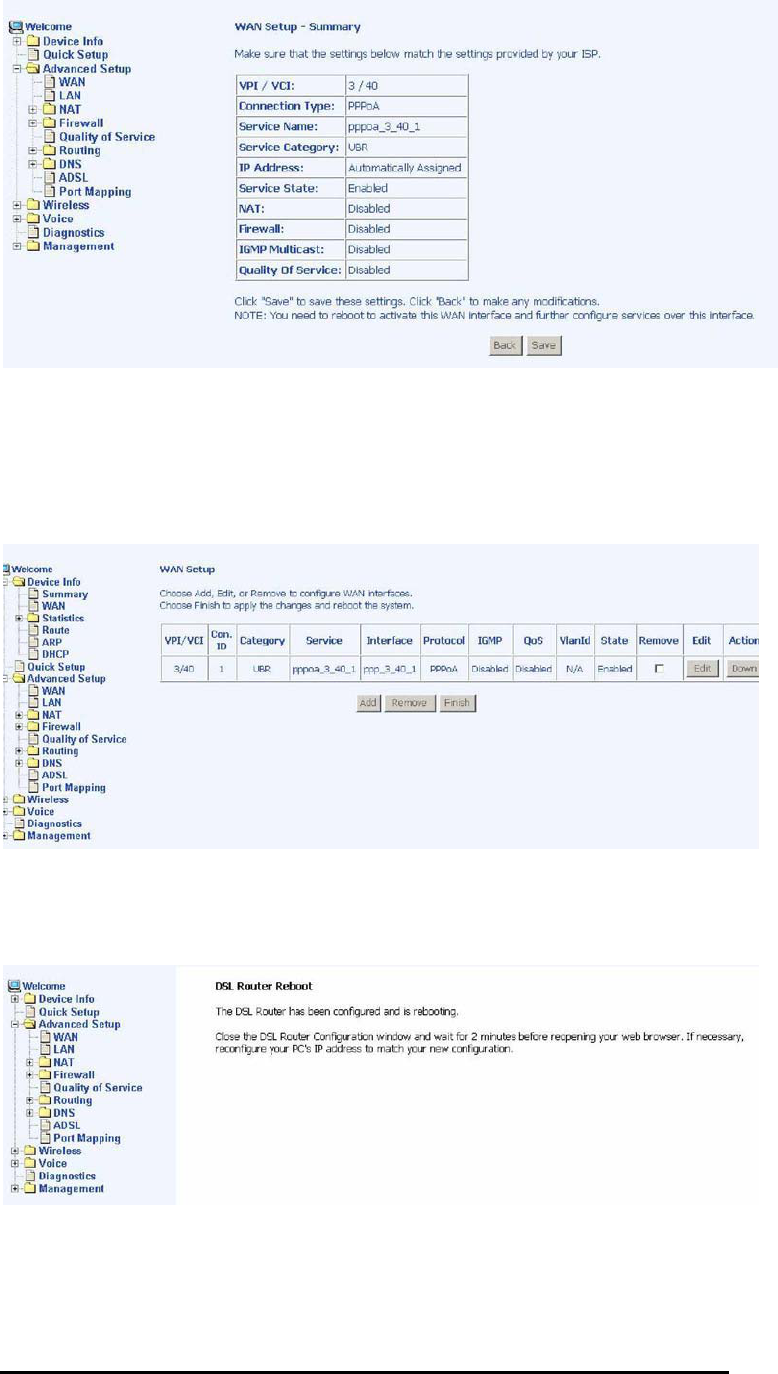
TriplePlay
User Manual 30
Version 1.0
Document #: BD-TU0001-10
After the settings are saved, the below screen will follow
displaying the WAN settings that you made with the option to Add
or Remove any of the connections that you have made. When
satisfied with the settings click on the Finish button.
After selecting the Finish button, the below screen will appear. At
this point, the router will reboot to save the changes made.
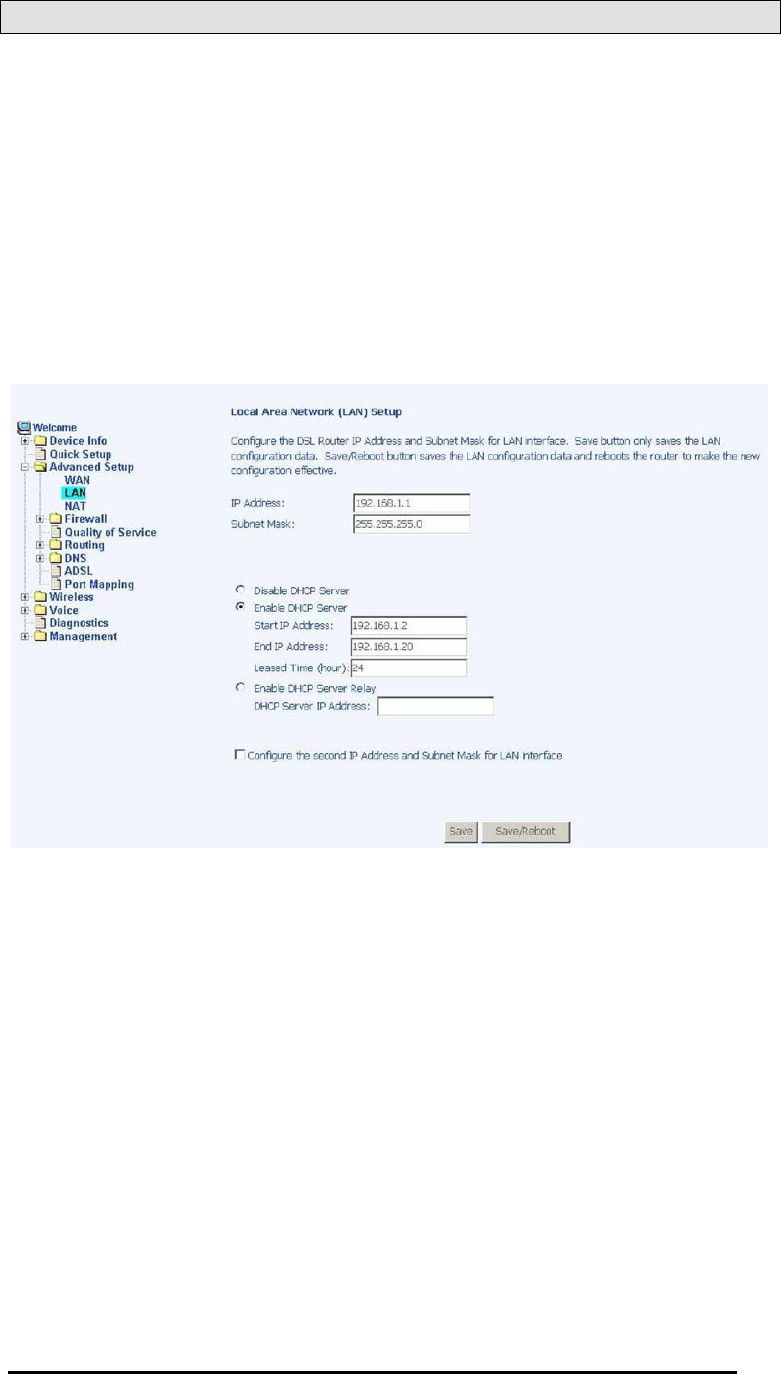
TriplePlay
User Manual 31
Version 1.0
Document #: BD-TU0001-10
LAN Local Area Network (LAN) Setup
You can configure the DSL Router IP address and Subnet Mask
for the LAN interface to correspond to your LAN’s IP Subnet. If
you want the DHCP server to automatically assign IP addresses,
then enable the DHCP server and enter the range of IP addresses
that the DHCP server can assign to your computers. Disable the
DHCP server if you prefer to manually assign IP addresses. Click
on Next to continue. The Save button only saves the LAN
configuration data, but does not apply the configurations. Select
the Save/Reboot button to save the LAN configuration data and
reboot the router and apply the new configurations.
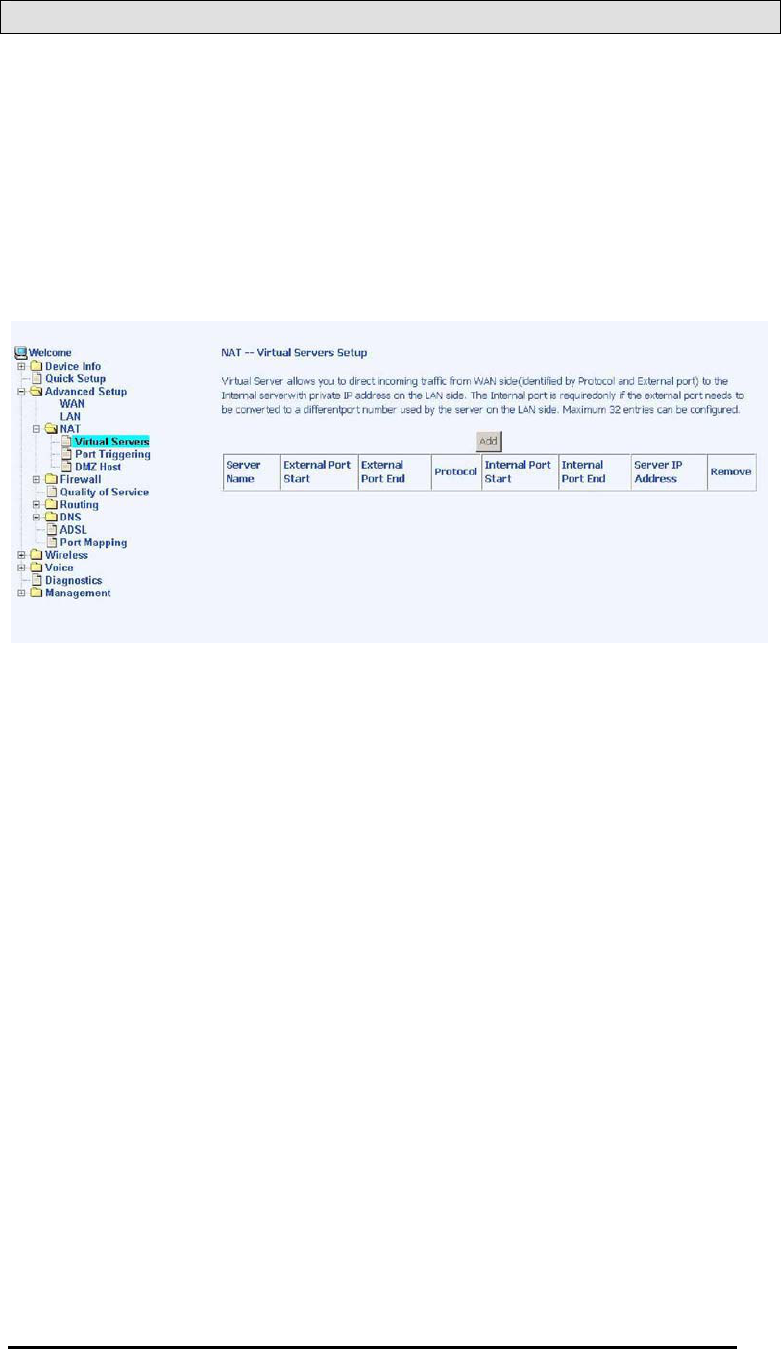
TriplePlay
User Manual 32
Version 1.0
Document #: BD-TU0001-10
NAT
If you enable NAT (Network Address Translation), you can
configure the Virtual Server, Port Triggering, and DMZ Host.
Virtual Servers
A virtual server allows you to direct incoming traffic from the WAN
side to a specific IP address on the LAN side. Click on Add to
configure a virtual server.
Select the virtual server from the drop-down list and complete the
server IP address, then click on the Save / Apply button.
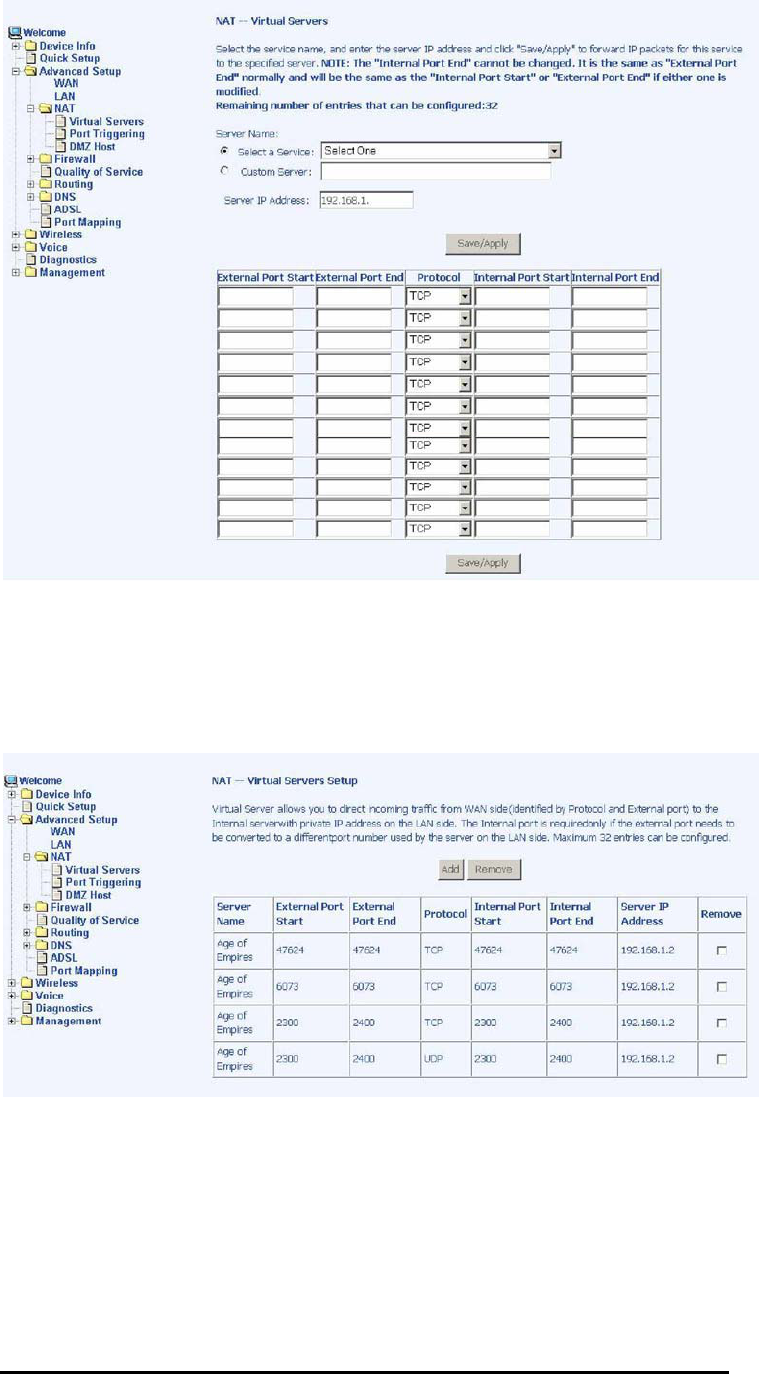
TriplePlay
User Manual 33
Version 1.0
Document #: BD-TU0001-10
The following screen appears after you save your selection. To
add additional virtual servers, click on the Add button. If you need
to remove any of the server names, select the check box and click
on the Remove button.
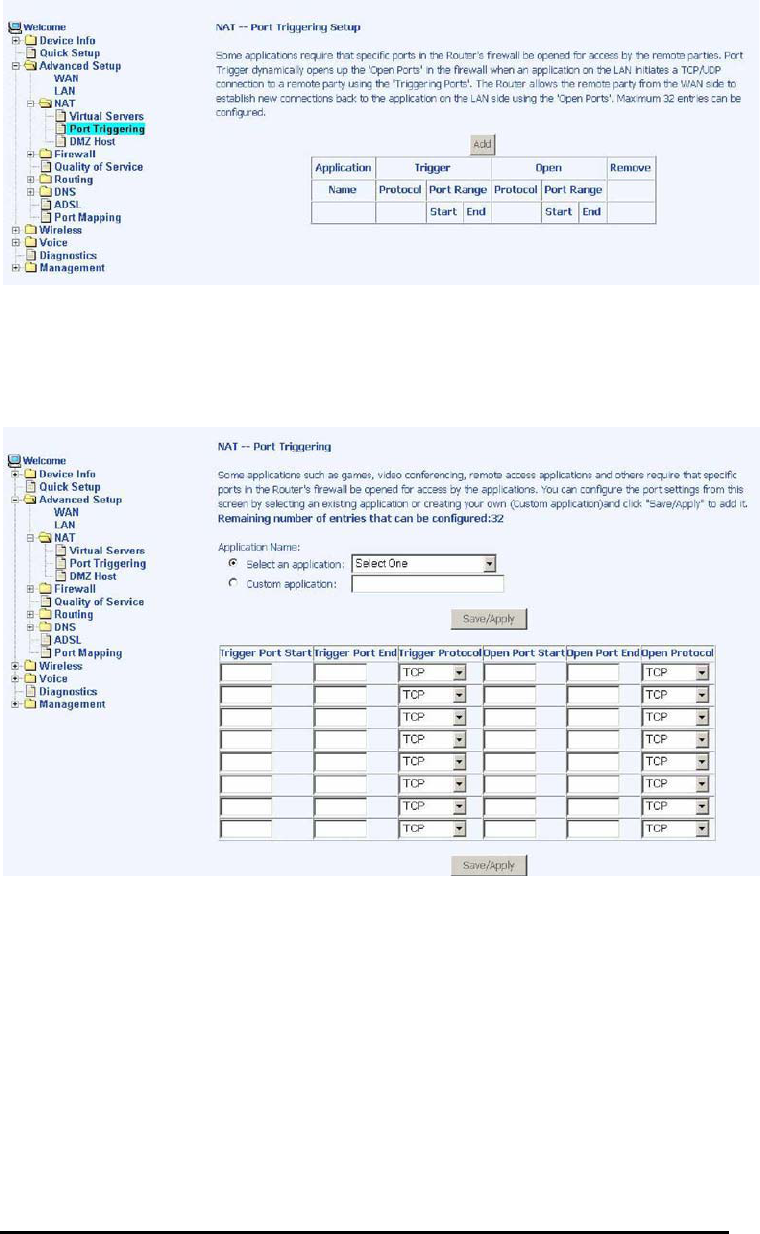
TriplePlay
User Manual 34
Version 1.0
Document #: BD-TU0001-10
Port Triggering
Click on the Add button to add Port Triggering to your Internet
application.
The below screen appears when you click on Add allowing you to
select the application that you want to set the port settings for.
After a selection has been made, click on the Save / Apply button.
The below screen appears after you save your selections. You
will be able to add or remove selections made, by clicking on the
Add and Remove buttons.
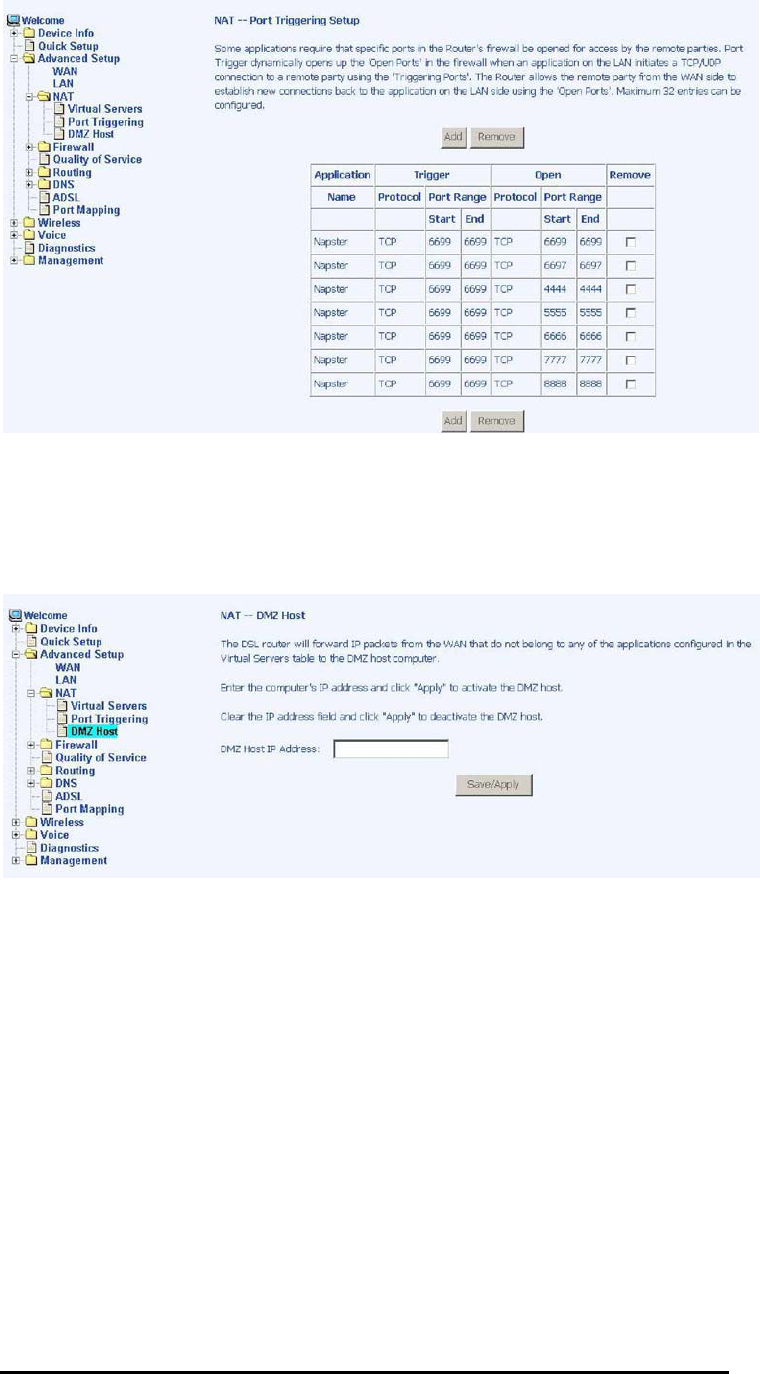
TriplePlay
User Manual 35
Version 1.0
Document #: BD-TU0001-10
DMZ Host
You can define the IP address of the DMZ Host on this screen.
Enter the IP address and click on Save / Apply.
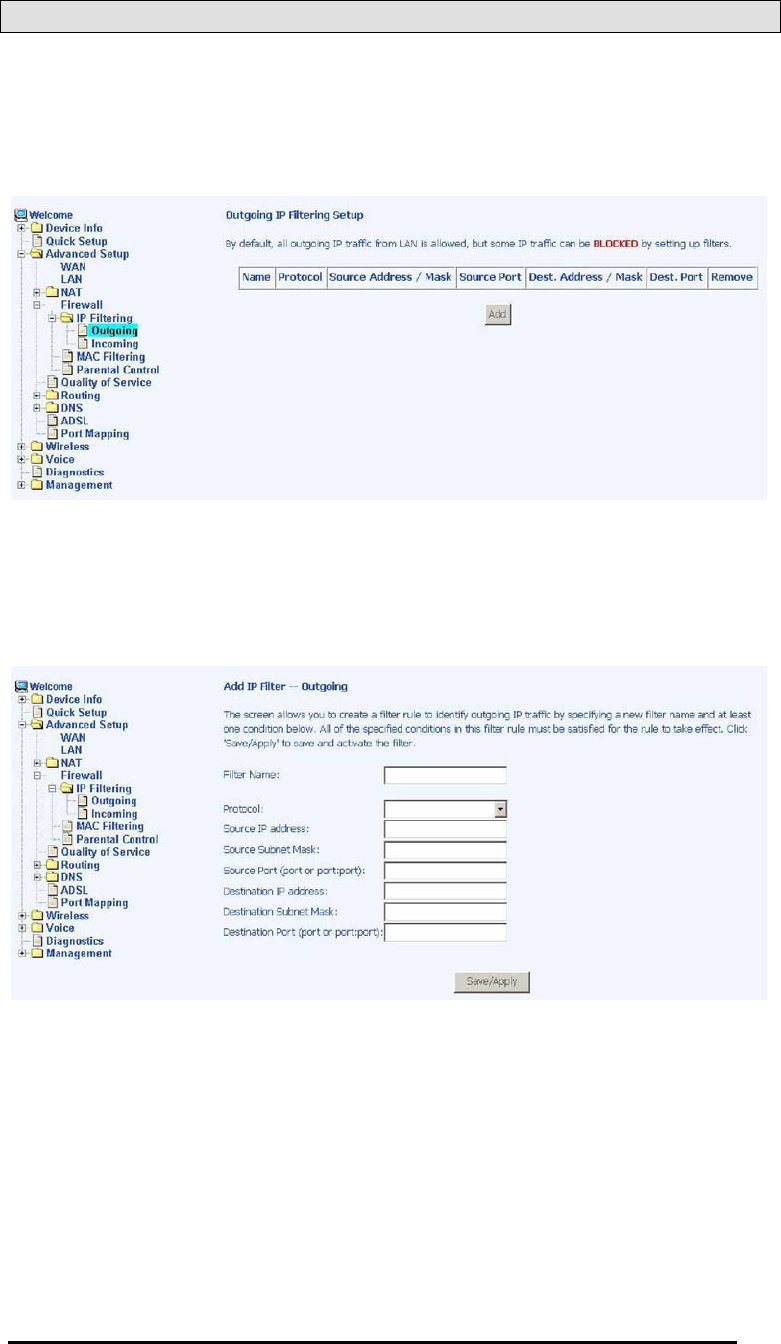
TriplePlay
User Manual 36
Version 1.0
Document #: BD-TU0001-10
Firewall
IP Filtering—Outgoing
The outgoing filter will block the LAN traffic from entering the
WAN side. Click on the Add button to create filters.
The below screen will appear when you click on Add. Input the
filter name, source information (from the LAN side), and
destination information (from the WAN side). Then click on Save /
Apply.
The following screen appears when you Save / Apply the IP filter.
The screen lists the IP filters that were added from the previous
screen. To change your settings, click on the Add or Remove
buttons.
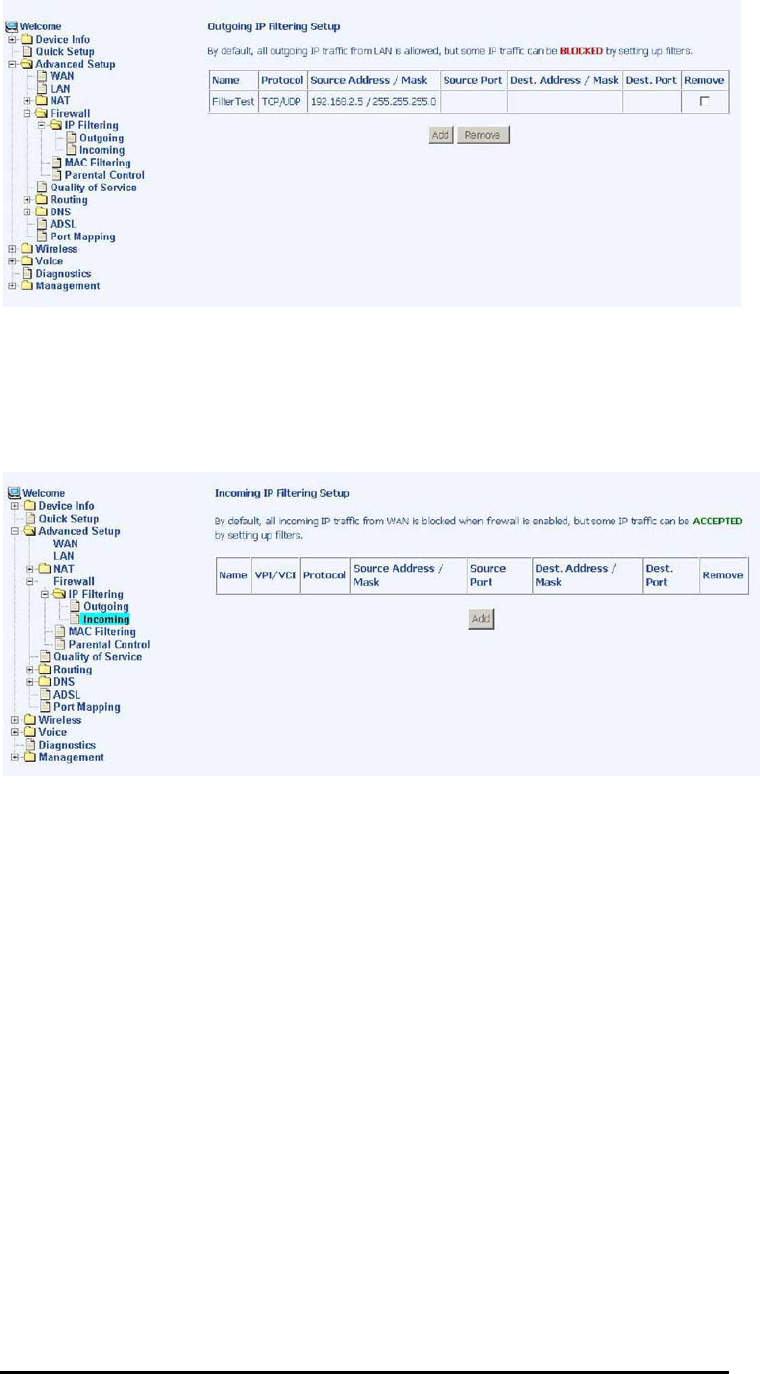
TriplePlay
User Manual 37
Version 1.0
Document #: BD-TU0001-10
IP Filtering—Incoming
Incoming IP filter filters the WAN traffic to the LAN side. Click on
the Add button to add incoming filter settings.
Enter a filter name, information about the source address (from
the WAN side), and information about the destination address (to
the LAN side). Select the protocol and WAN interface, then click
on Save/Apply to add the setting.
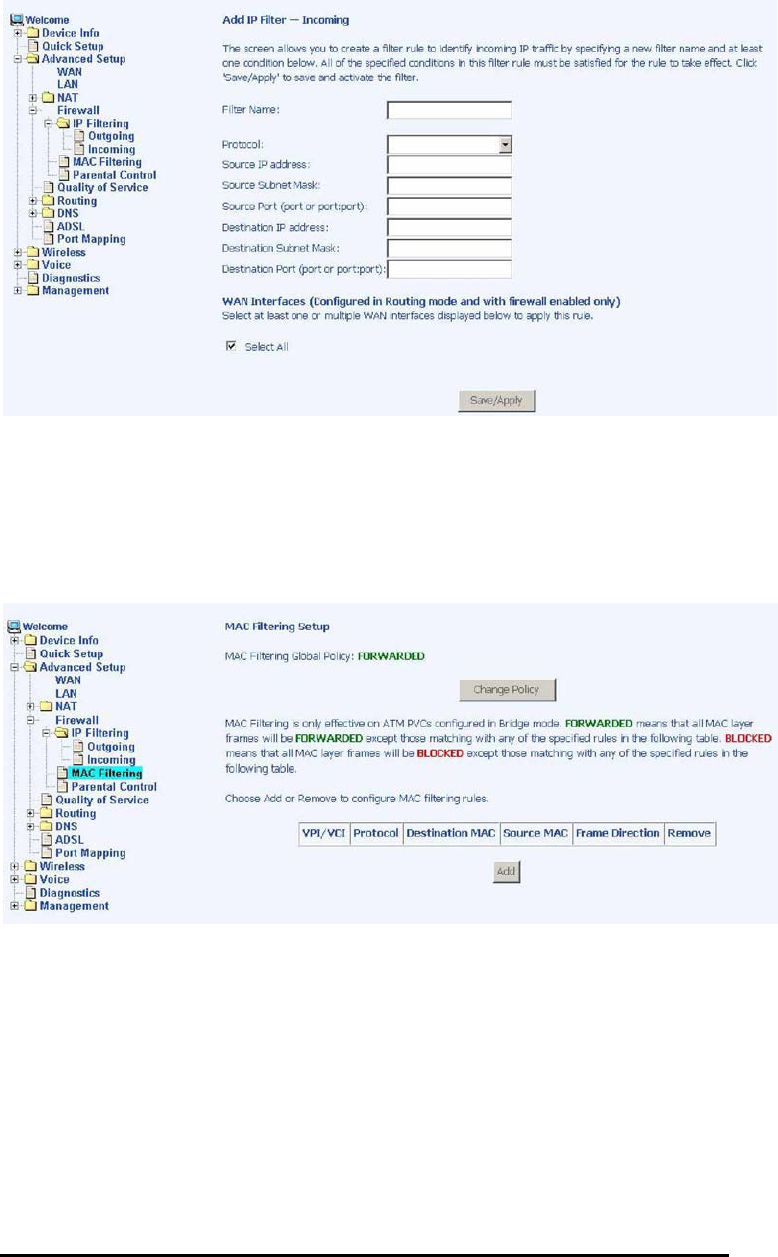
TriplePlay
User Manual 38
Version 1.0
Document #: BD-TU0001-10
You can view and delete the incoming filter settings from this
screen.
MAC Filtering
MAC filtering can forward or block traffic by MAC address. You
can change the policy or add settings to the MAC filtering table
using the MAC Filtering Setup screen.
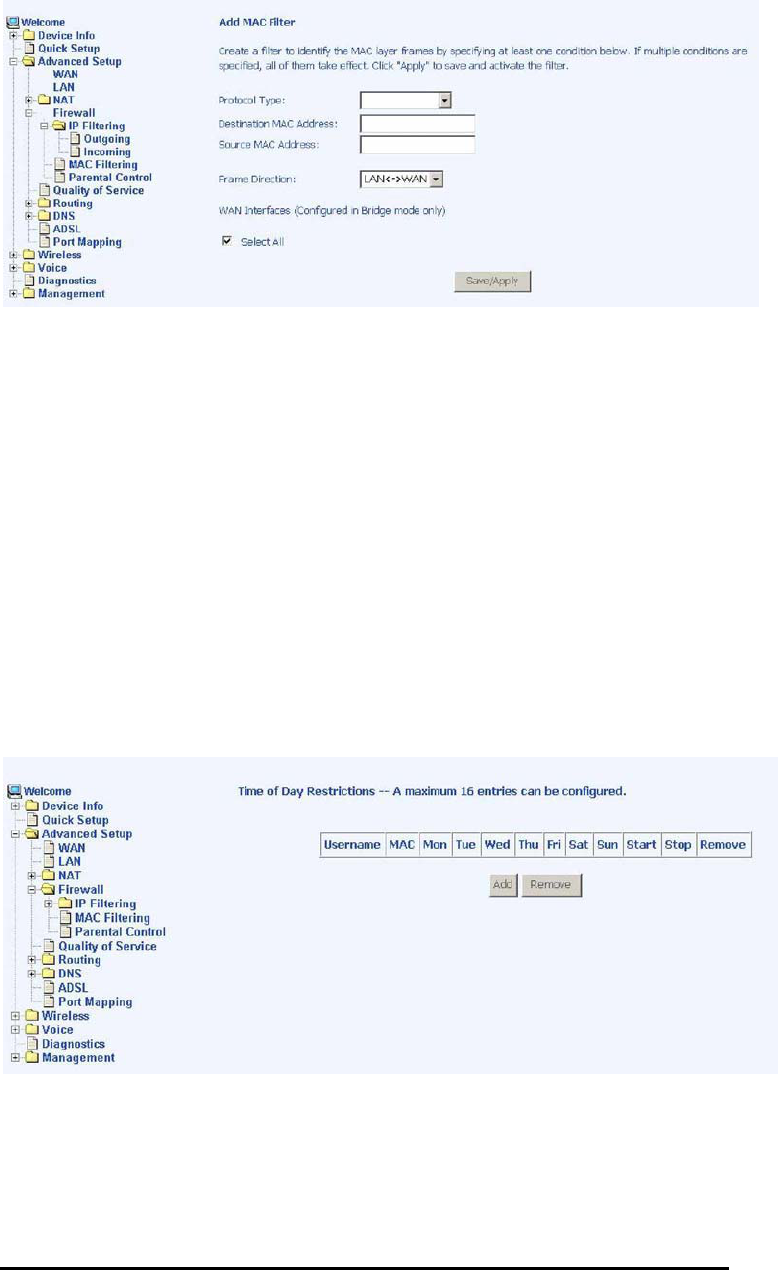
TriplePlay
User Manual 39
Version 1.0
Document #: BD-TU0001-10
If you click on Change Policy, a confirmation dialog allows you to
verify your change.
If you want to add a setting to the MAC filtering table, enter the
Source and Destination MAC address, and select protocol type,
frame direction, and WAN interface. Then click on Save / Apply to
save it.
After you save the settings, a screen showing the settings will
appear. On this screen you will be able to view and delete MAC
filtering rules.
Parental Control
In a home setting, parents can also restrict the day of the week
certain computers can access the router. Click on Add to set up
the restrictions.
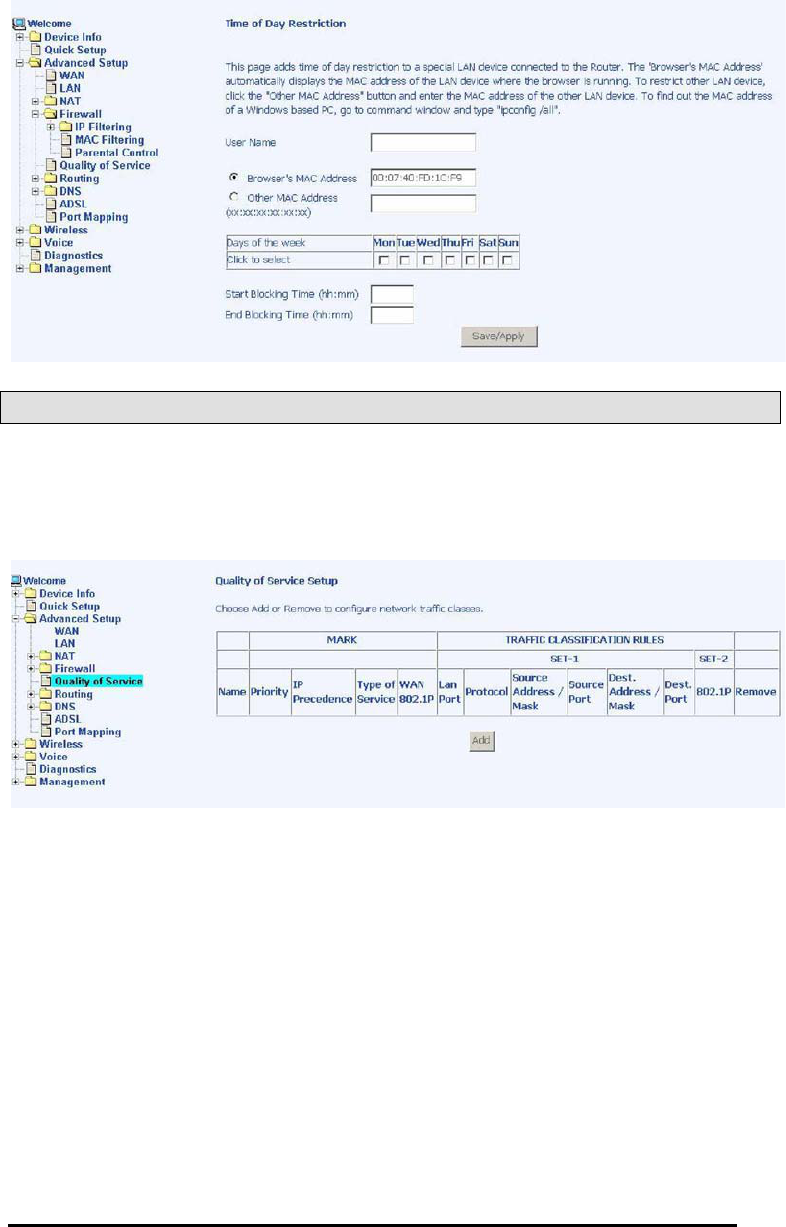
TriplePlay
User Manual 40
Version 1.0
Document #: BD-TU0001-10
To set up a restricted user, enter the user name, the MAC
address, and select the days to restrict. You can also enter the
start and end of the blocking time. When completed, click on
Save / Apply.
Quality of Service
You can configure the Quality of Service to apply different
priorities to traffic on the router. Click on Add to configure network
traffic classes.
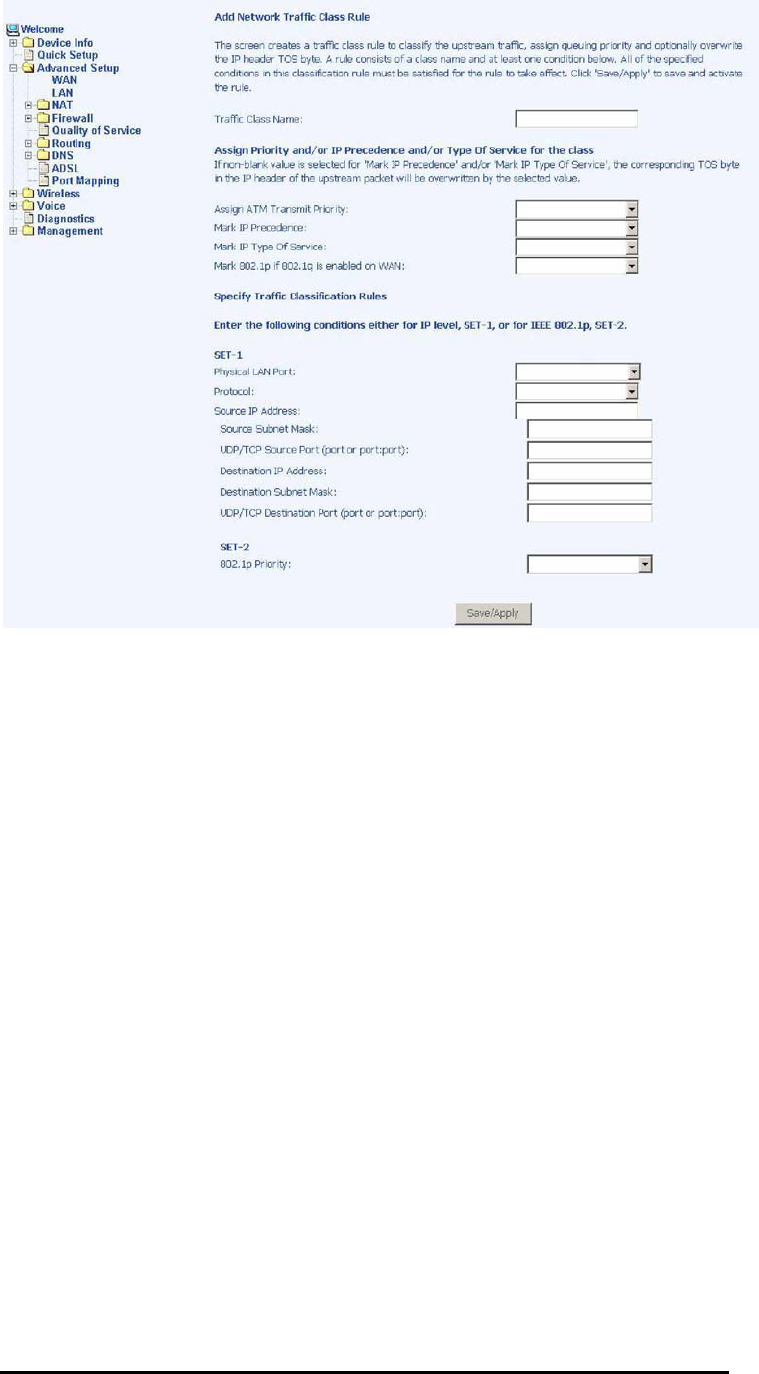
TriplePlay
User Manual 41
Version 1.0
Document #: BD-TU0001-10
•Traffic Class Name— the name that you name this class of traffic for
which you are configuring quality of service
•Assign ATM Transmit Priority— select from low, medium, or high
priority level for transmitting ATM packets.
•Mark IP Precedence— used to mark a packet to notify the network in
regard to the importance of the packet. IP precedence values range
from 0-7 with 6 and 7 reserved and should not be used. The 8
precedence values have the following meanings—
o(0) – Routine
o(1) – Priority
o(2) – Immediate
o(3) – Flash
o(4) – Flash Override
o(5) – Critical
o(6) – Internetwork Control
o(7) – Network Control
•Mark IP Type of Service— select from the following choices—
oNormal Service
oMinimize Cost
oMaximize Reliability
oMaximize Throughput
oMinimize Delay
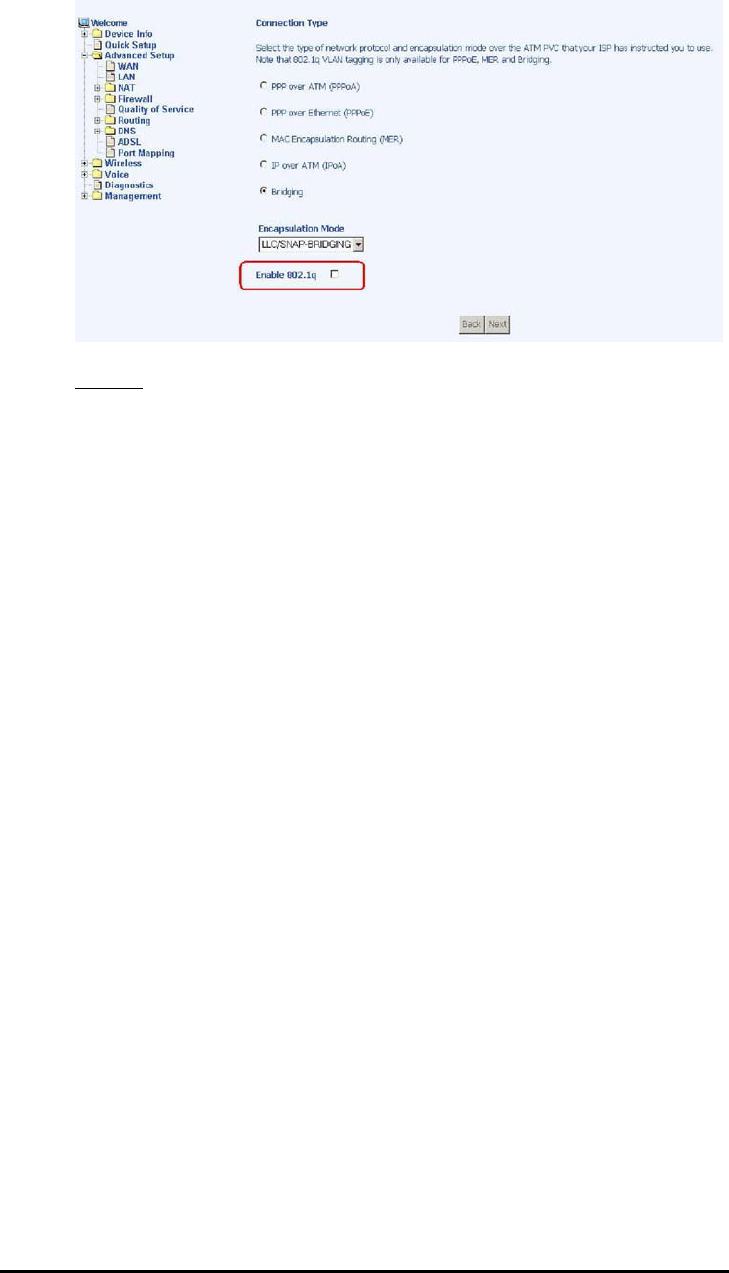
TriplePlay
User Manual 42
Version 1.0
Document #: BD-TU0001-10
•Mark 802.1p if 802.1q is enabled on WAN— (see below ”Connection
Type” screen located under “WAN” under “Advanced”.) The values
range from 0-7.
NOTE: Enter the following conditions either for SET-1 or for SET-2.
SET-1
•Physical LAN Port— select the physical port—Ethernet LAN 1-4, USB,
or wireless
•Protocol— select from the following protocols—TCP/UDP, TCP, UDP, or
ICMP
•Source IP Address— the IP address for the computer which packets
are coming from
•Source Subnet Mask— the subnet mask for the source of the packets
being sent
•UDP / TCP Source Port (port or port:port)— if TCP or UDP was
selected , then enter the port number
•Destination IP Address— the IP address of the computer where the
packets will be sent to
•Destination Subnet Mask— the subnet mask for the destination of the
packets being sent to
•UDP / TCP Destination Port (port or port:port)— if TCP or UDP was
selected , then enter the port number
SET-2
•802.1p Priority— if 802.1q was enabled on WAN, then select a value
between 0-7.
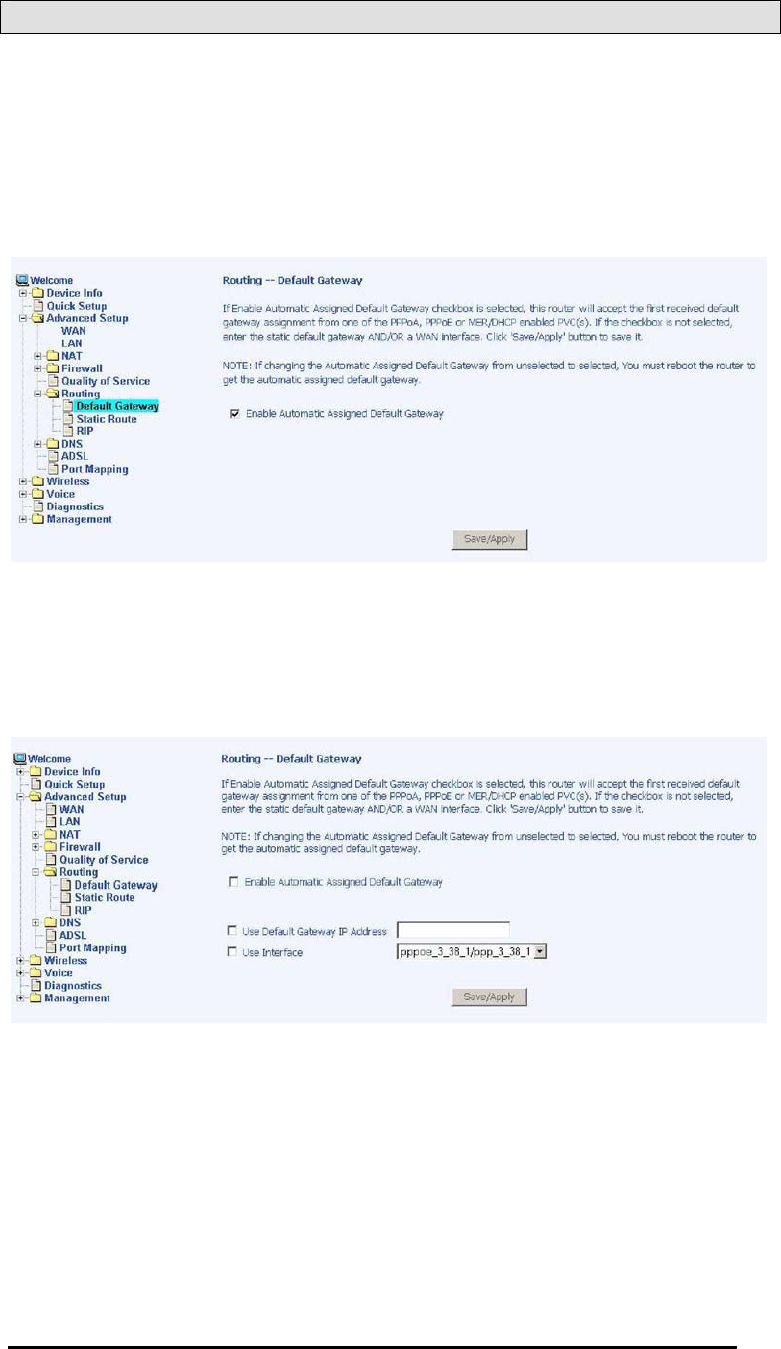
TriplePlay
User Manual 43
Version 1.0
Document #: BD-TU0001-10
Routing
Default Gateway
You can enable automatic assigned default gateway on the
Routing – Default Gateway screen. As default, the box is checked
for automatic assigned default gateway to be enabled. Click the
Save / Apply button to enable or disable this feature.
By deselecting the Enable Automatic Assigned Default Gateway
option, you will be asked to manually enter the default gateway IP
address and select the appropriate user interface that you will be
using. Click on Save / Apply to continue.
Static Route
The Static Route screen can be used to add a routing table (a
maximum of 32 entries can be configured). Click on Next to add.
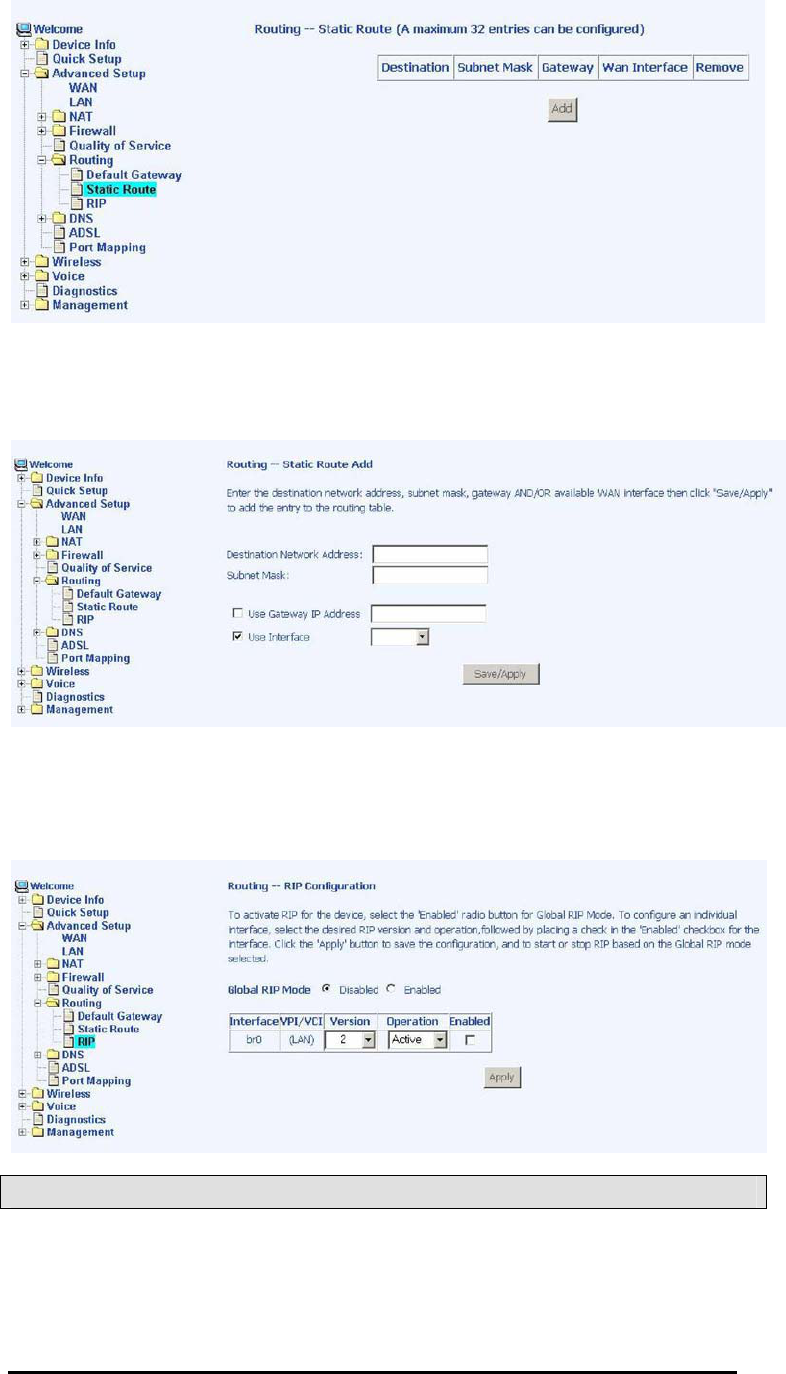
TriplePlay
User Manual 44
Version 1.0
Document #: BD-TU0001-10
Enter the route information and then save and apply your
configurations.
RIP
If RIP is enabled, the router operation can be configured as active
or passive.
DNS
DNS Server
Use the DNS Server screen to enable automatic assignment of a
DNS or to specify a primary and secondary DNS.
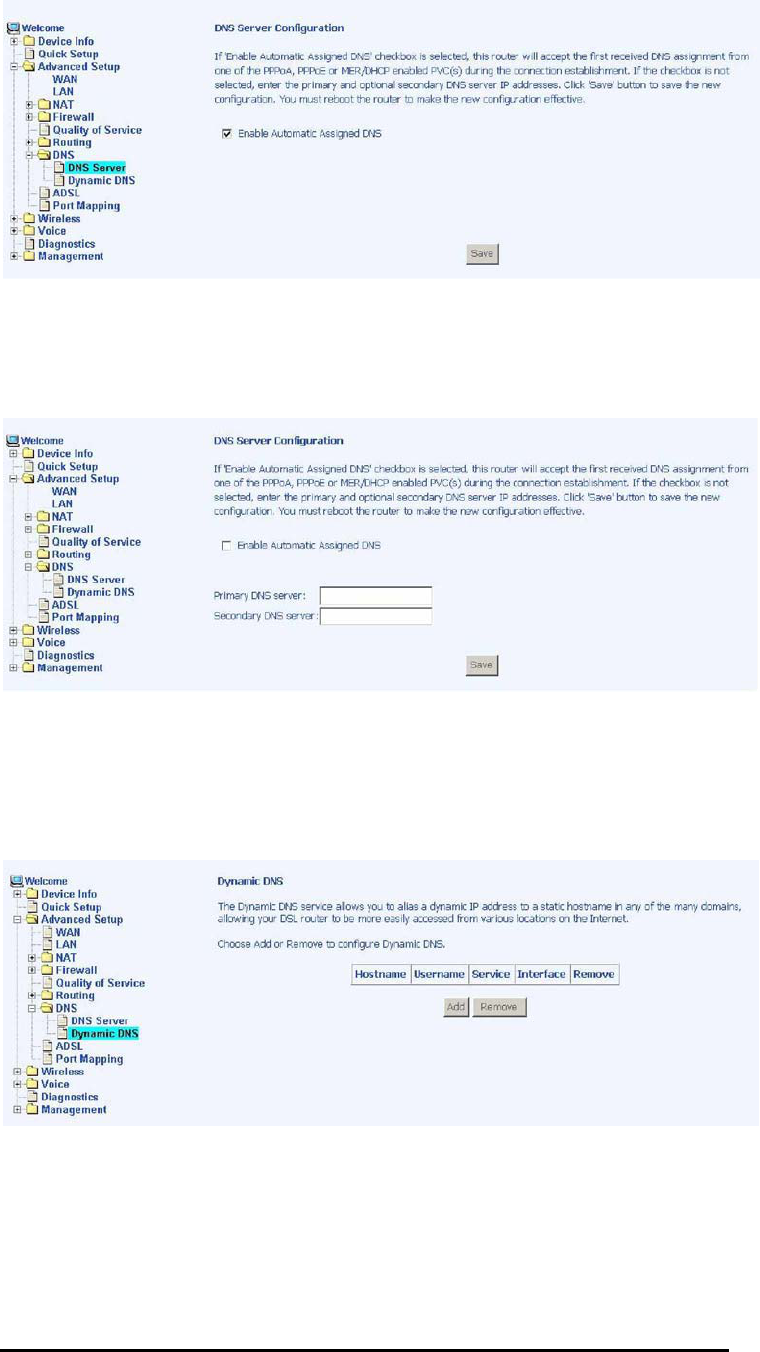
TriplePlay
User Manual 45
Version 1.0
Document #: BD-TU0001-10
If you uncheck the Enable Automatic Assigned DNS checkbox,
then there will be two additional fields—primary and secondary
DNS server—to enter as seen below.
Dynamic DNS
Access “Dynamic DNS” located under “DNS”. Dynamic DNS
(Domain Name Service) is a system that allows more than one IP
address to be assigned to one domain name.
The following Add dynamic DDNS screen allows you to set up
your DDNS server. Select the Dynamic DNS provider from the
list—DynDNS.org or TZO. Enter the hostname and the ADSL
interface and the username / password provided by the DNS
server site. Note that you will need to register first at DynDNS.org.
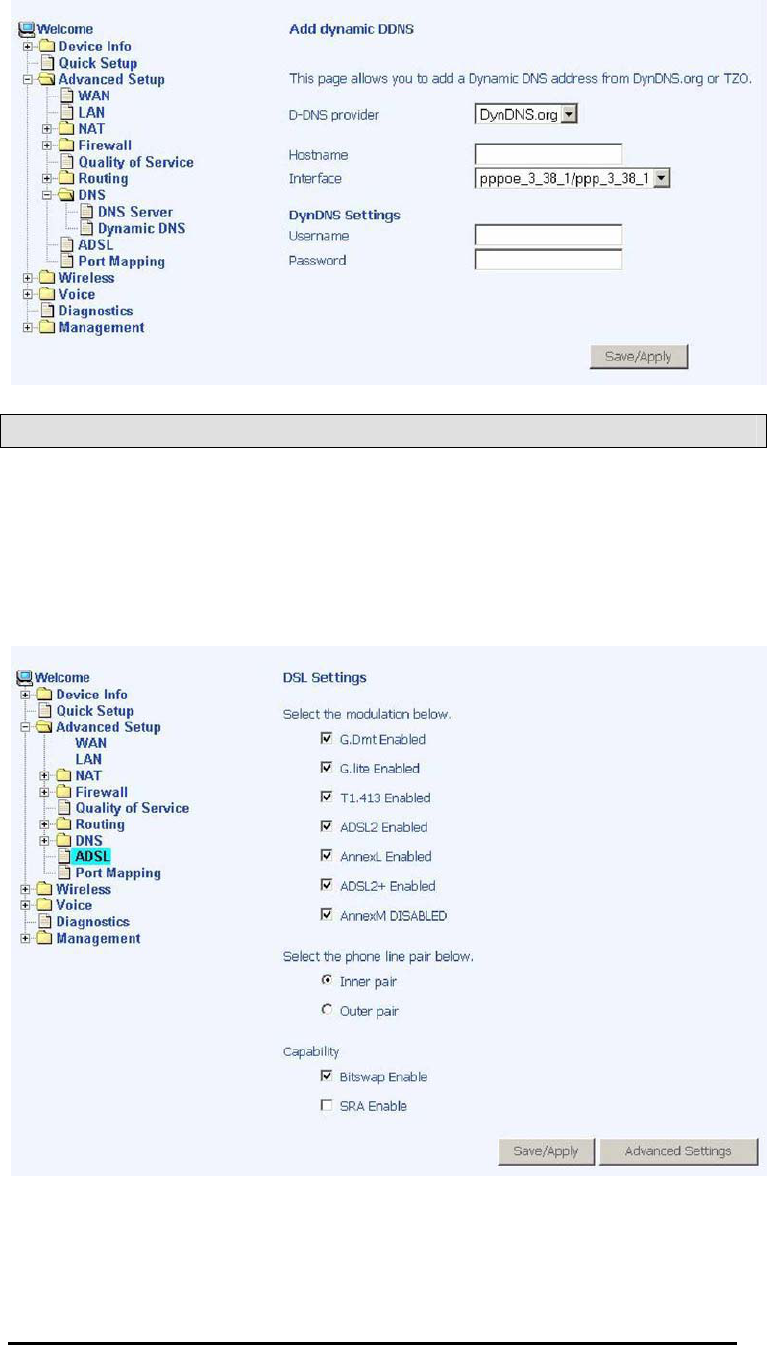
TriplePlay
User Manual 46
Version 1.0
Document #: BD-TU0001-10
ADSL
The DSL settings screen contains three sections—modulation,
phone line, and capability—that should be specified by your ISP.
Consult with your ISP to select the correct settings for each. Then
click on Save / Apply if you are finished or click on Advanced
Settings if you want to configure more advanced settings.
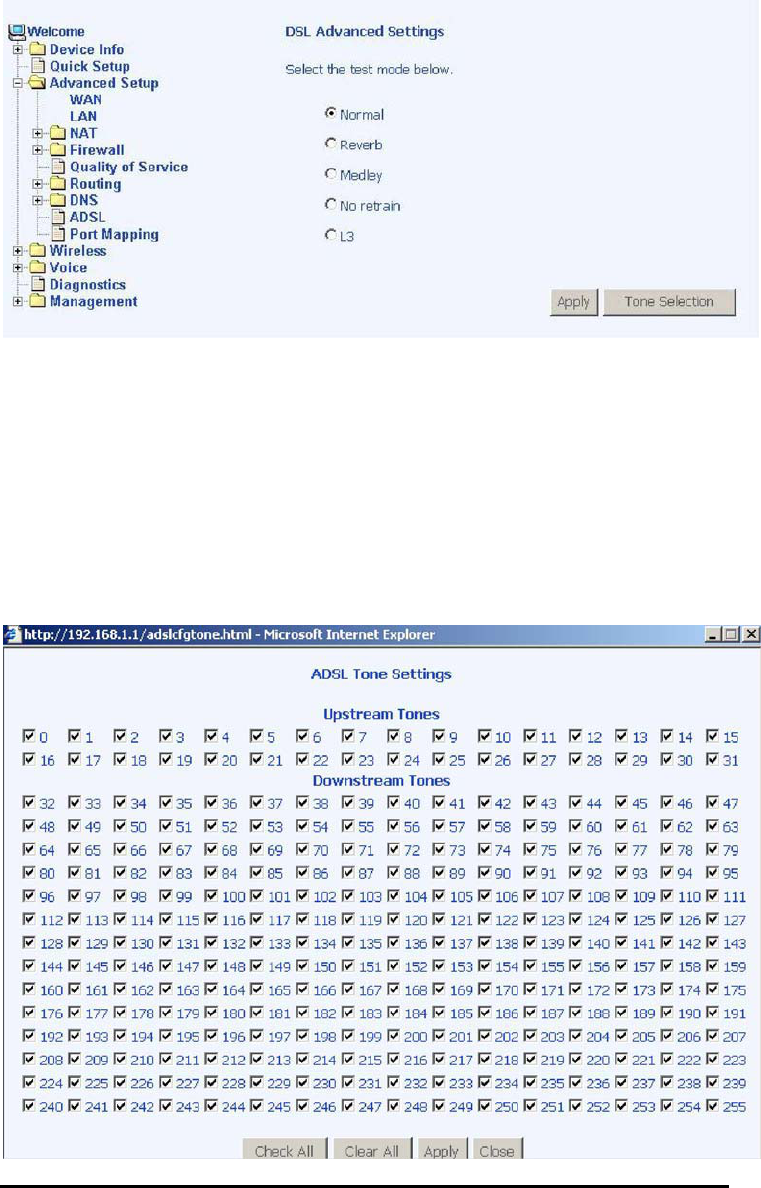
TriplePlay
User Manual 47
Version 1.0
Document #: BD-TU0001-10
DSL Advanced Settings
The test mode can be selected from the DSL Advanced Settings
screen.
Test modes include—normal, reverb, medley, no retrain, and L3.
Tone Settings
The frequency band of ADSL is split up into 256 separate tones,
each spaced 4.3125 kHz apart. With each tone carrying separate
data, the technique operates as if 256 separate modems were
running in parallel. The tone range is from 0 to 31 for upstream
and from 32 to 255 for downstream. Do not change these settings
unless so directed by your ISP.
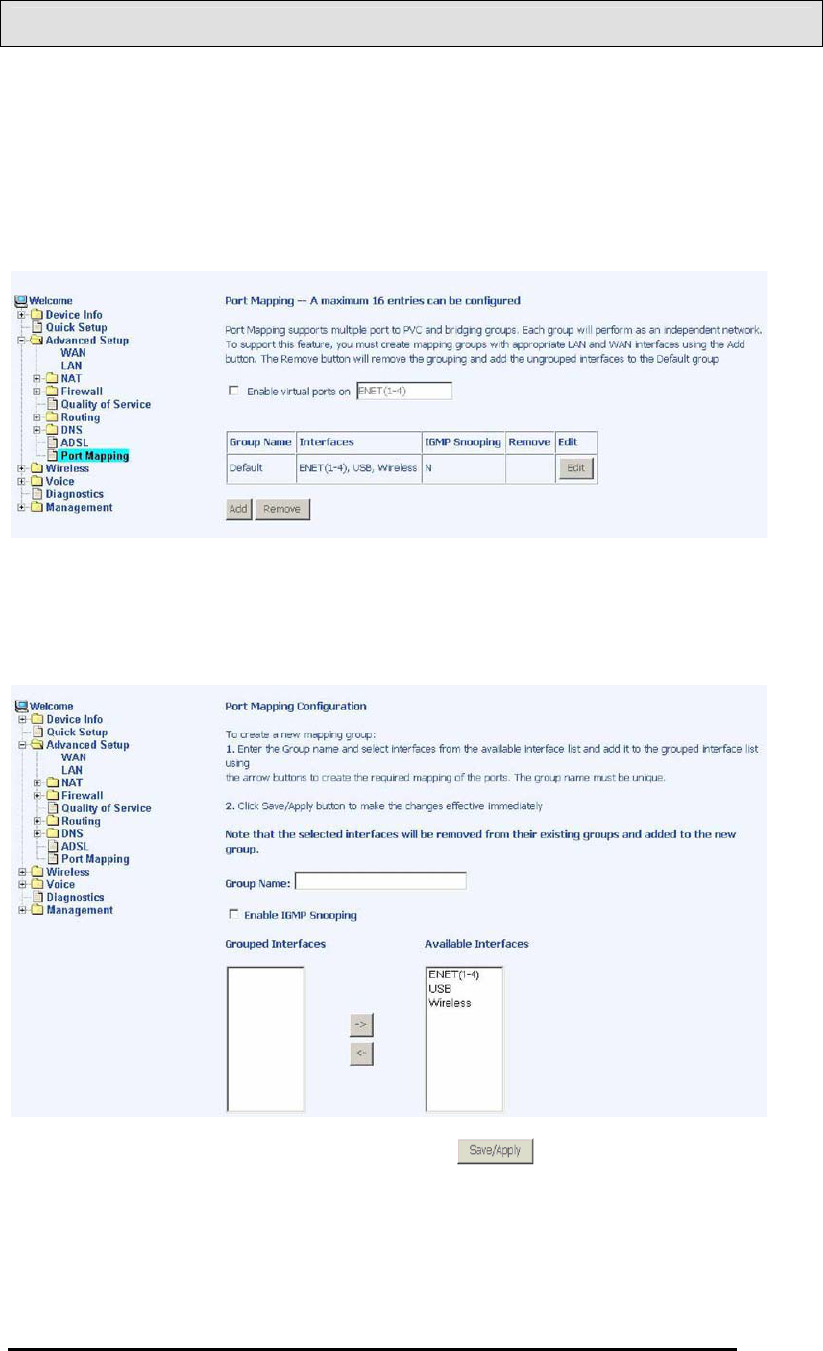
TriplePlay
User Manual 48
Version 1.0
Document #: BD-TU0001-10
Port Mapping
Port mapping is a feature that allows you to open ports to allow
certain Internet applications on the WAN side to pass through the
firewall and enter your LAN. To use this feature, mapping groups
need to be created.
Click on the Add button as displayed below.
After clicking the Add button, the below configuration screen
appears, allowing you to enter the groups and the interfaces they
are associated with.